Pocket Square Folds are a Pocketful of Fun!
A pocket square is the perfect finishing touch to any outfit, and this little accessory can drastically alter your entire look’s mood, palette, and formality. But did you know that you can derive even greater versatility from a pocket square by changing how you fold it?
- Pocket Square Folds are a Pocketful of Fun!
- Select the Correct Fold for the Correct Pocket Square and Occasion
- The Classic Fold
- The Crown or Multi-Point Fold
- The Puff or Pinch Fold
- The Upside-Down Puff or Upside-Down Pinch Fold
- The Shell Fold
- The Scallop Fold
- The Rose Fold
- The Angel’s Peak Fold
- Bonus: The Stair Fold
- Conclusion
- Outfit Rundown
- Previous Pocket Square Fold Content
The plethora of folds you can employ can add even greater range to your pocket square collection. Access to these unique folds will effectively double, triple, or even quadruple the size of your pocket square wardrobe, as the different folds can highlight various aspects of each type of pocket square, effectively making them look like different articles with every fold.
In this guide, you will learn how to fold eight different classic pocket square folds, plus a special bonus. All of these folds are in keeping with the conventions of Classic Style and will afford you countless opportunities for debonair styling typical of a perfectly folded pocket square.
Select the Correct Fold for the Correct Pocket Square and Occasion
Not Every Pocket Square Fold Is Suited to Every Outfit
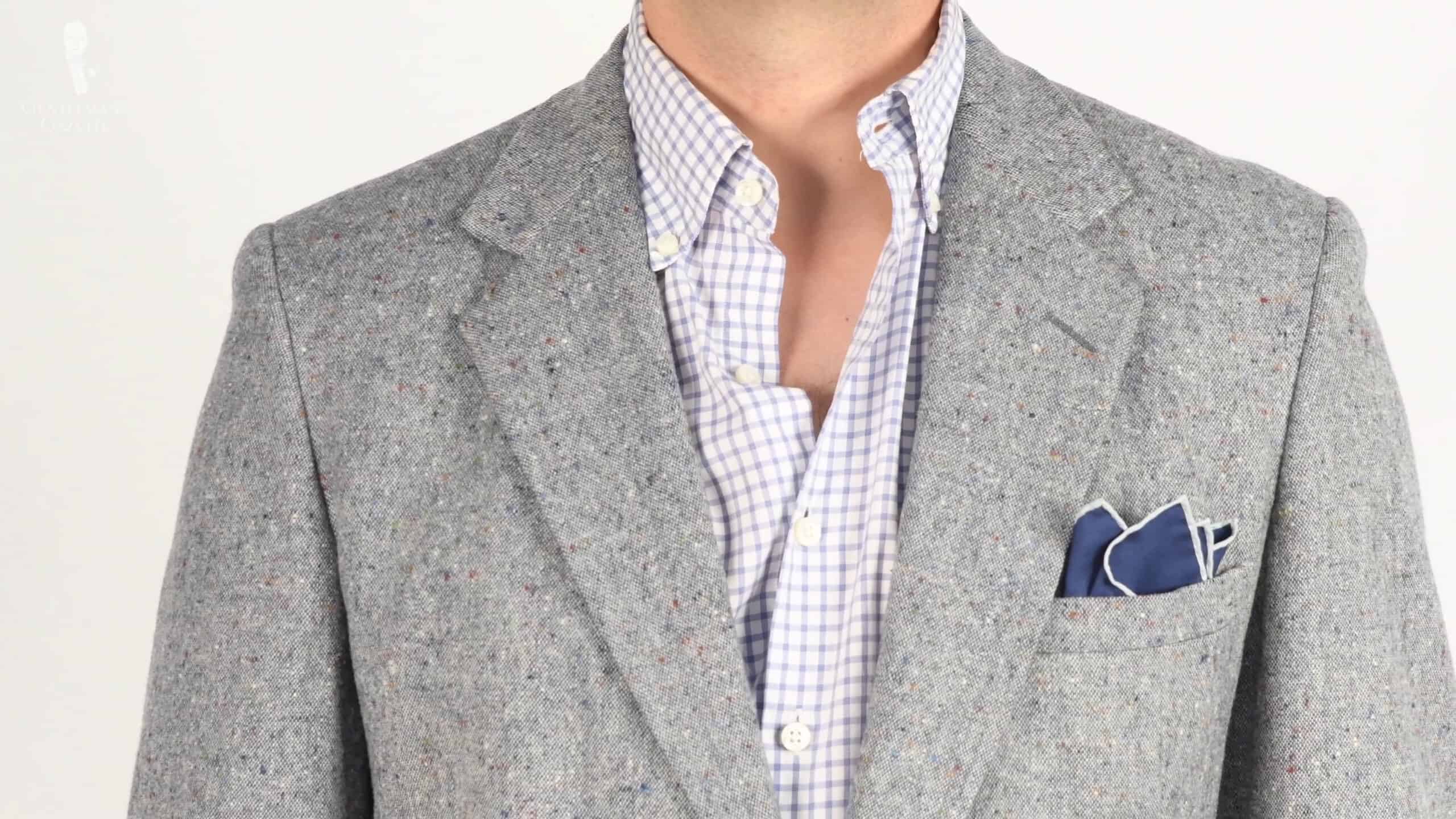
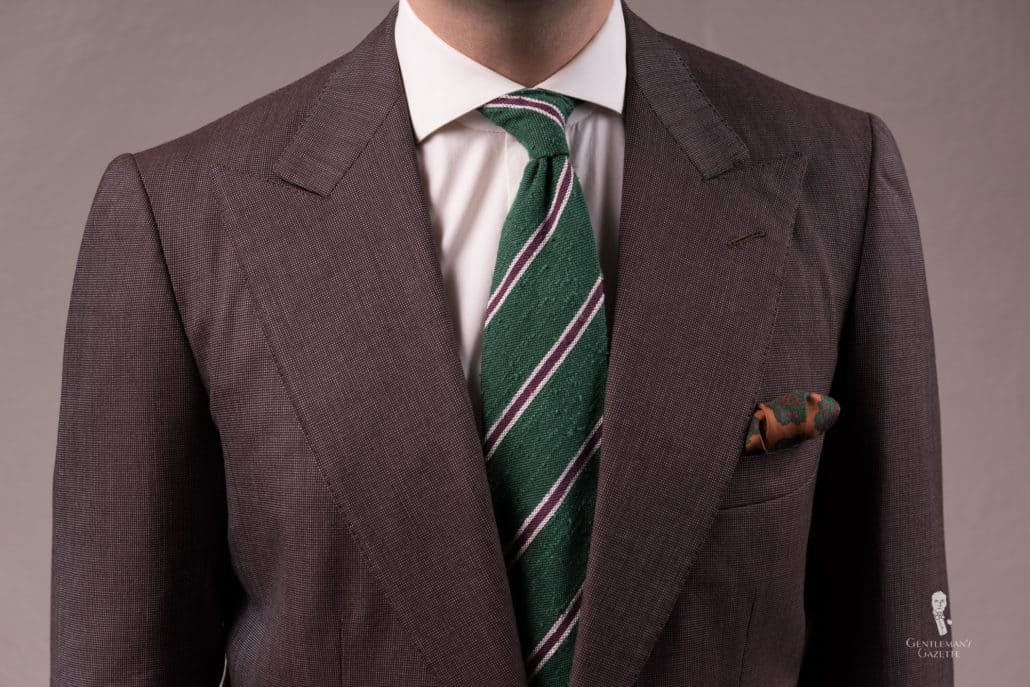
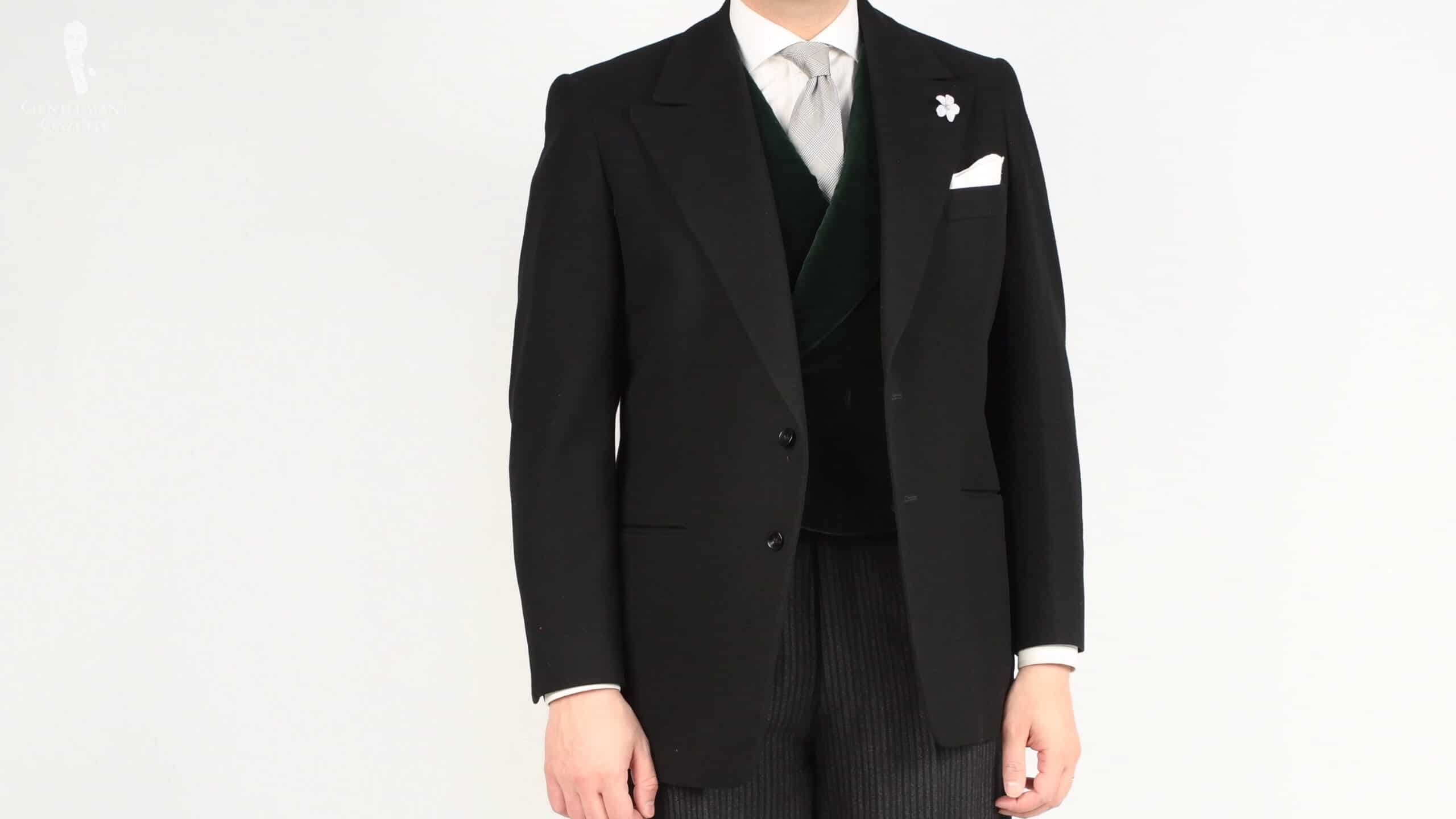
Contrary to what many people assume, specific folds are suited to specific types of pocket squares. The material from which the pocket square is made is a primary deciding factor in whether a fold is viable and appears elegant with that material – certain folds work best with stiffer, more robust fabrics, while others look best with plush or soft fabrics.
Other types of folds will best complement particular designs or patterns on the pocket square, depending upon which portion of the pocket square is most visible when the folded article is placed in the pocket.
Finally, based on their appearance, certain folds are generally more casual or more formal than others. As such, you will want to consider relative formality when deciding on which fold to employ.
Materials Affect Fold Functionality
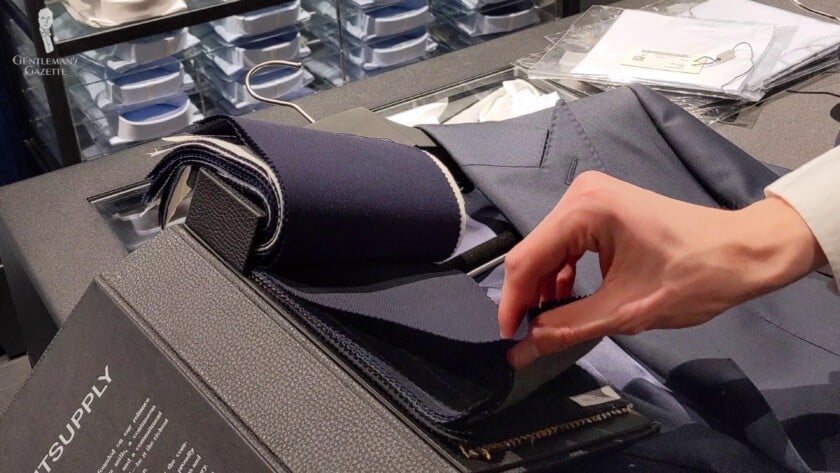
Pocket squares are traditionally made from a handful of materials: cotton, linen, wool, silk, and blends of the same.
The distinctive characteristics of each of these fabrics will determine how well they perform when employed in different types of folds. Precise folds with hard architectural lines will generally require a stiffer fabric. Plush, organic folds will generally benefit from a softer, more luxurious material.
Material can also determine how well and how vibrantly details like color and image clarity are reflected on the pocket square. Madder silk, in particular, is renowned both for its soft feel and its rich colors.
Understanding which materials are best suited to each fold will enable you to achieve the most refined look, and we will provide our suggestions for the best materials for each of the following folds.
Learn more about pocket square materials!
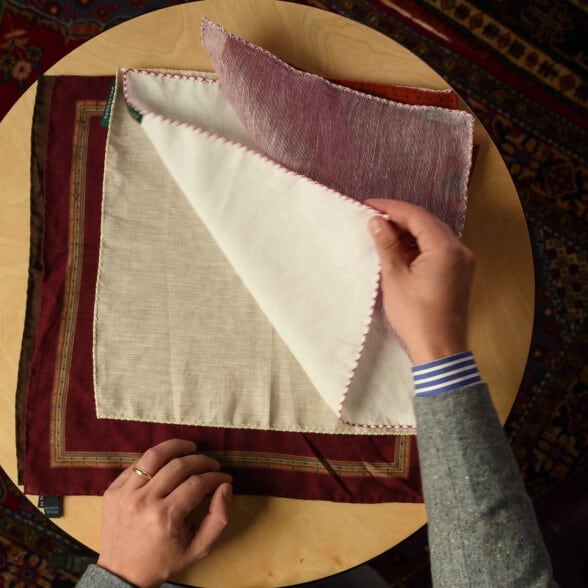
When it comes to pocket squares…
Size Matters!
The best way to ensure that your pocket square sits secure and stationary in your jacket pocket is to match the size to the material. Slick, thin fabrics can slide down into the pocket, while thick, rigid fabrics can form into unsightly bunches. Generally speaking, a smaller pocket square size should be used for thicker material and a larger size for thinner material. Be wary of any pocket square manufacturer that uses one size for all pocket squares, regardless of material.
Patterns and Design Affect Fold Appearance
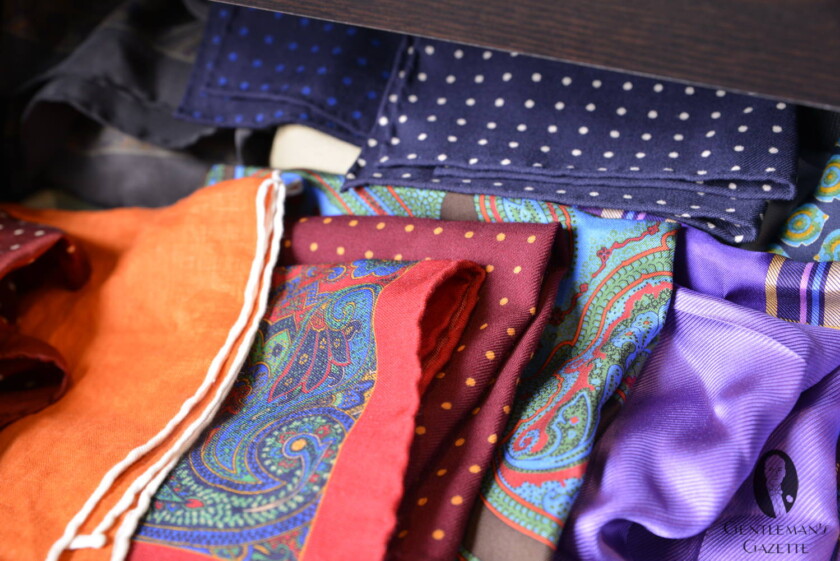
When a pocket square is folded, the particular fold will dictate which portions of the pocket square are displayed. Most folds will either highlight the edges of the pocket square, the body of the pocket square, or portions of both.
Pocket squares can come in a variety of different designs and patterns, but, for the purpose of selecting the best folds, you will want to focus on distinguishing between pocket squares with primarily detailed edges, like x-stitching or a prominently rolled edge, and pocket squares with bold central detailing, like a medallion, repeating pattern, or graphic.
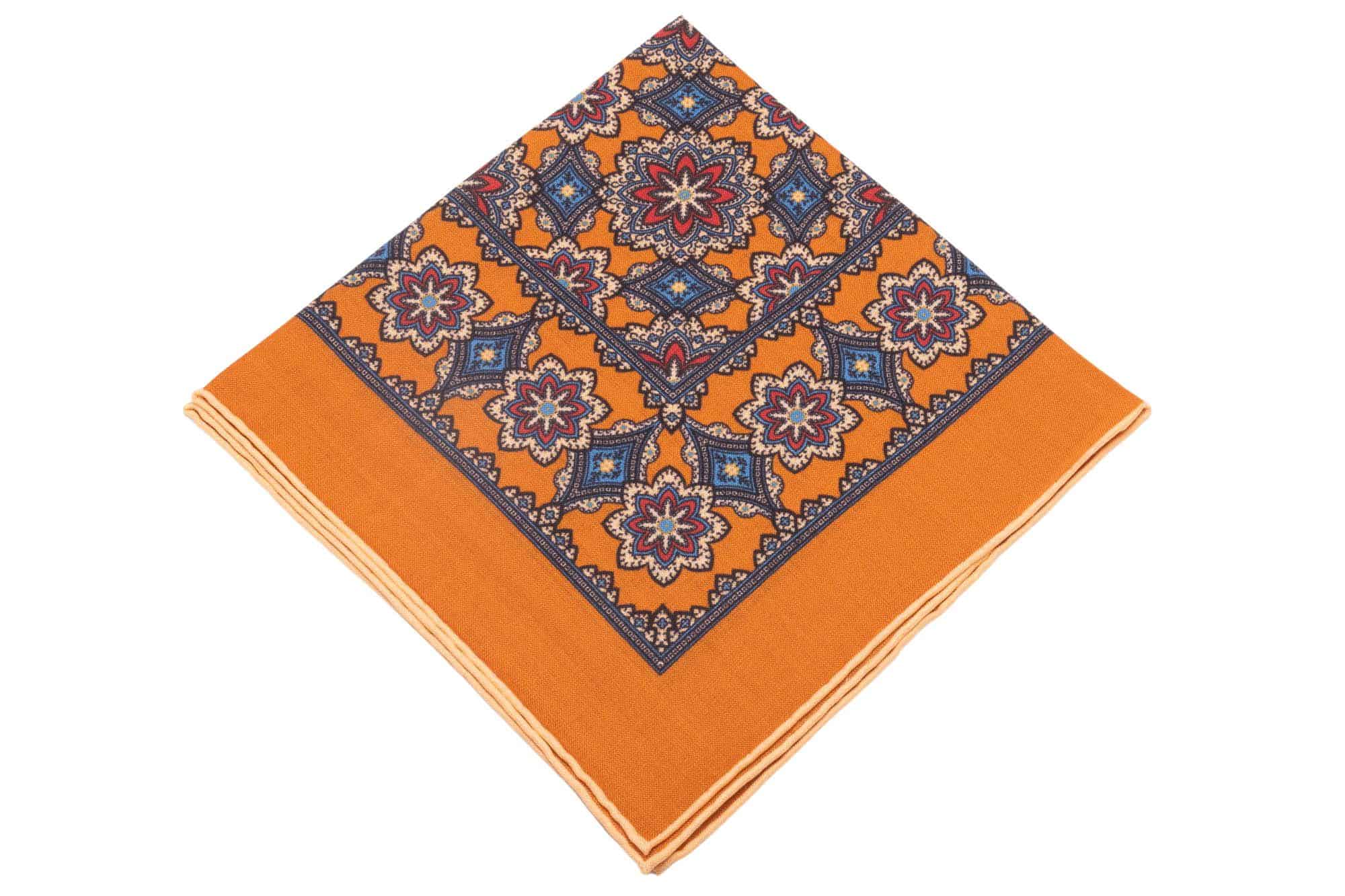
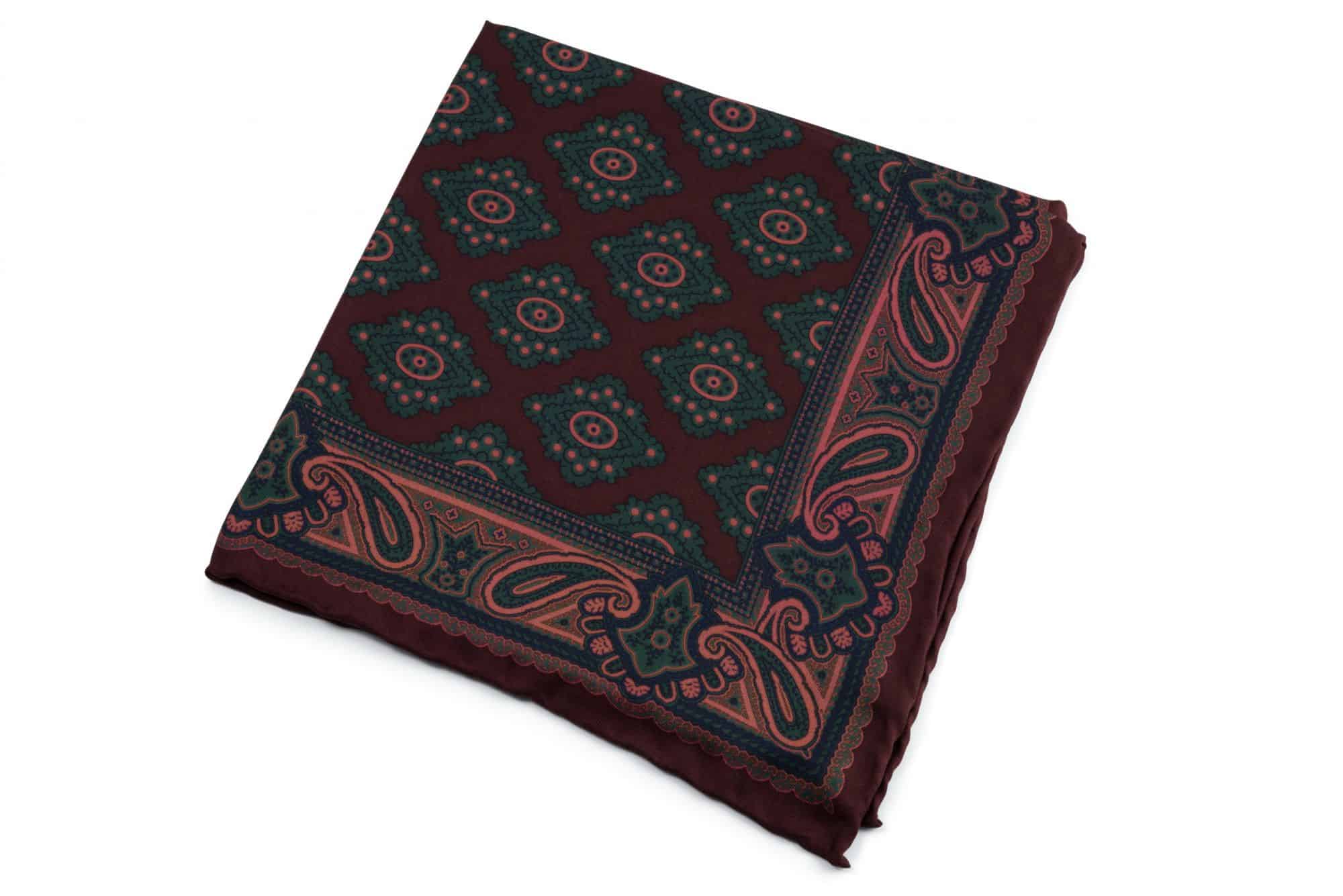
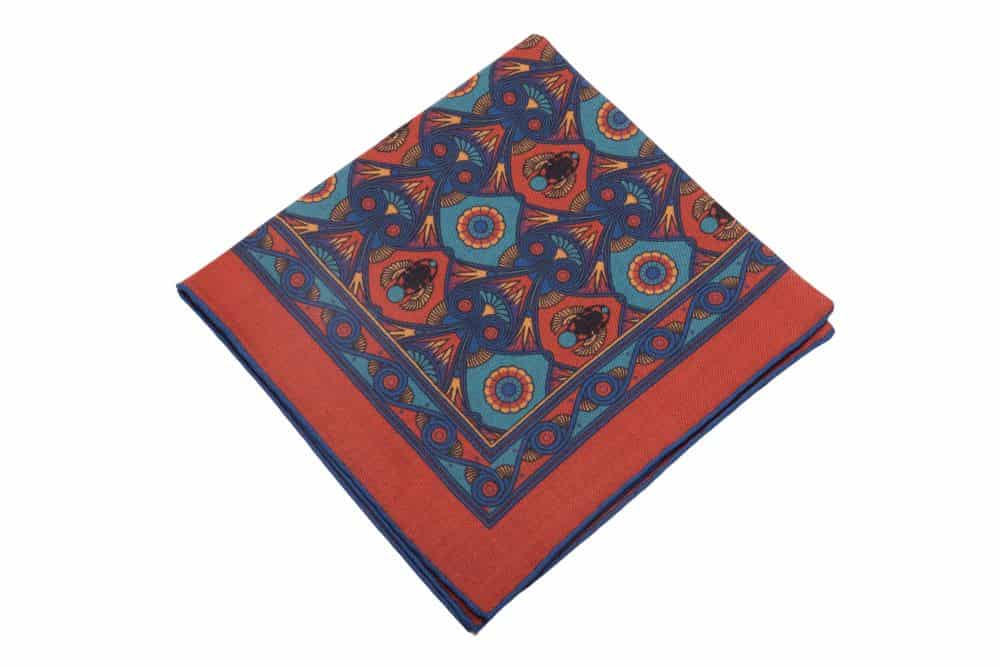
A fold that highlights the body of a pocket square offers the best visual interest when the utilized pocket square has dramatic central detailing like a medallion. Folds that emphasize the borders of a pocket square, conversely, are better suited to pocket squares with unique edge detailing like x-stitching or unexpected texture. Where applicable, this guide includes suggestions as to which patterns work best with each fold.
See our 9 essential pocket squares!
Formality Affects Fold Effectiveness
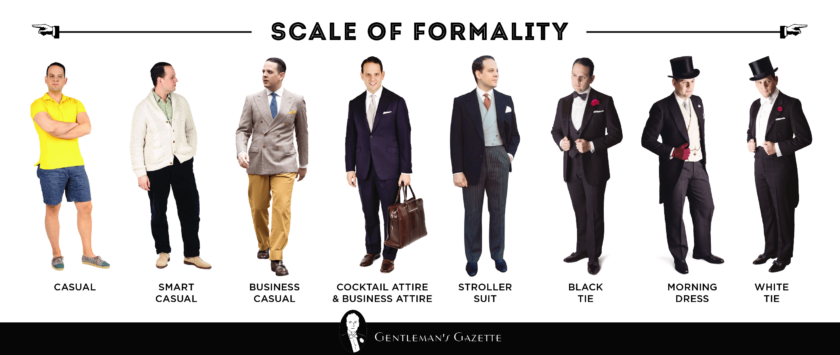
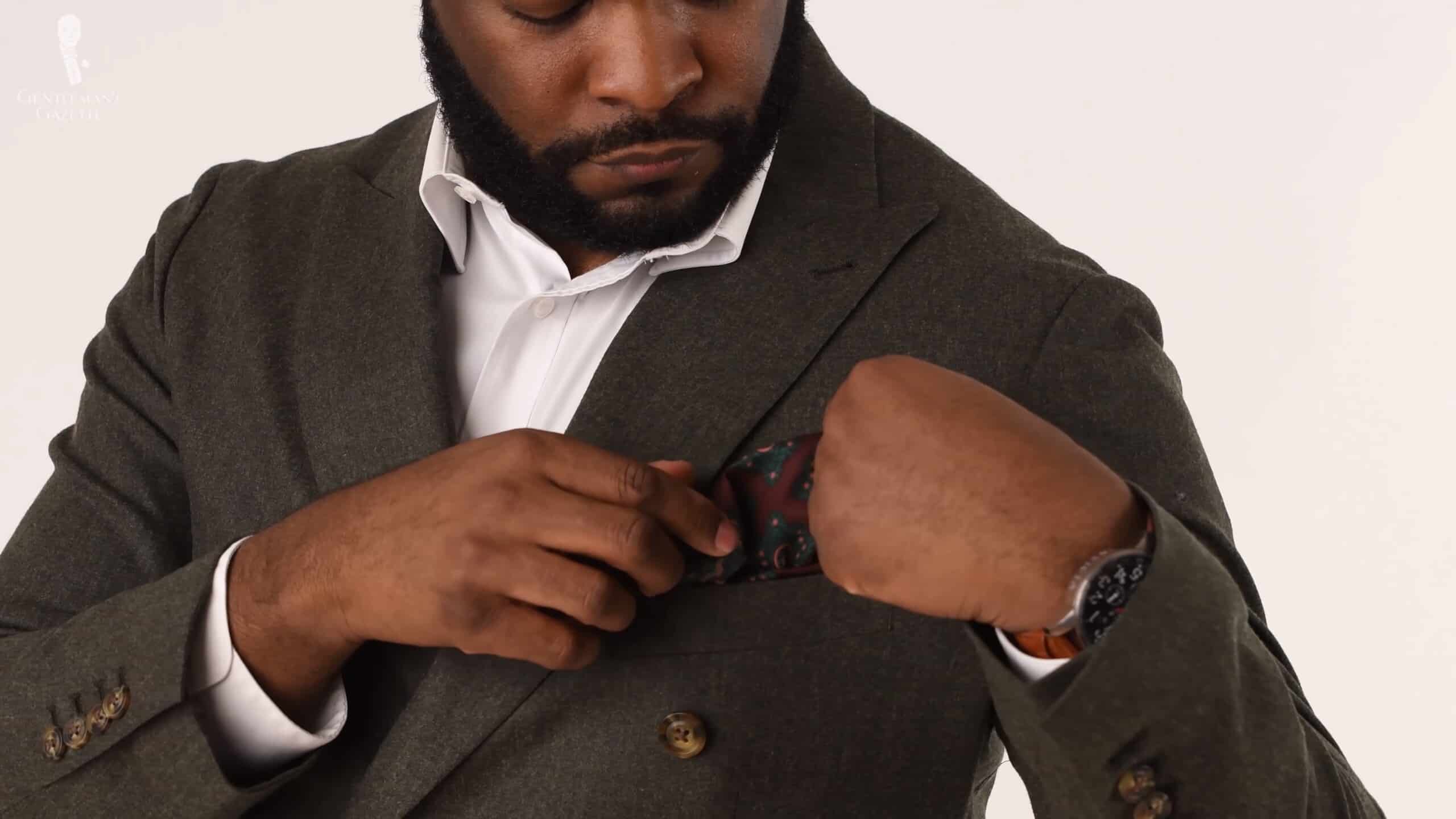
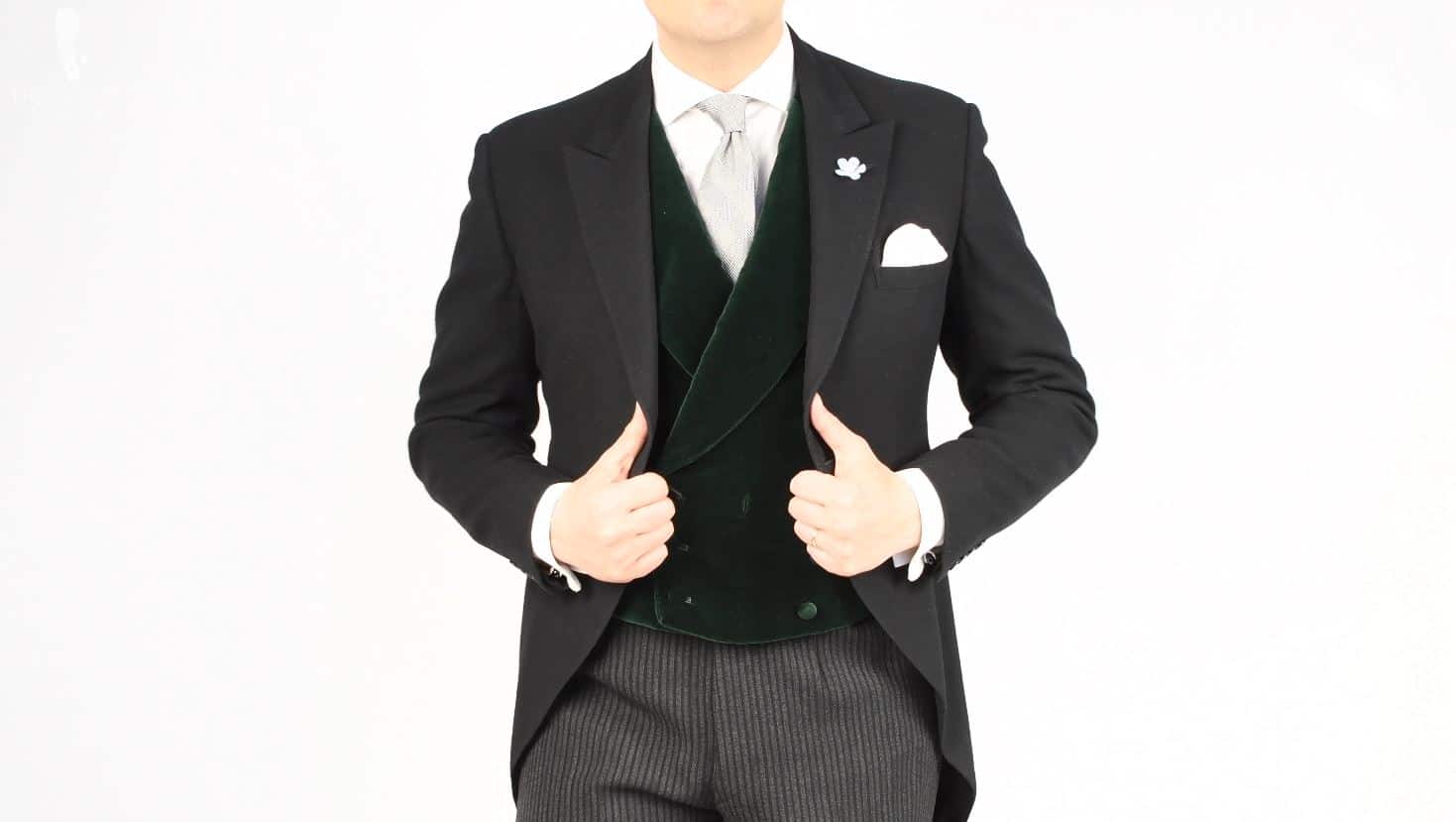
Based upon aesthetics and traditional conventions, many pocket square folds can be classified as casual, business casual, business attire, semi-formal, and formal, usually running the gamut between several dress codes. This relative formality will determine whether a fold is appropriate for settings like the office or a nice restaurant or very formal occasions like the Black Tie dress code.
Generally speaking, the more visually complicated a fold is, the more casual it is. This fact is especially obvious regarding highly architectural, geometric pocket square folds. Conversely, pocket square folds consisting of simple triangular or square lines or natural organic curves are more formal.
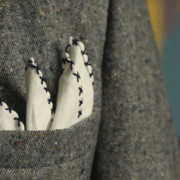
Casual
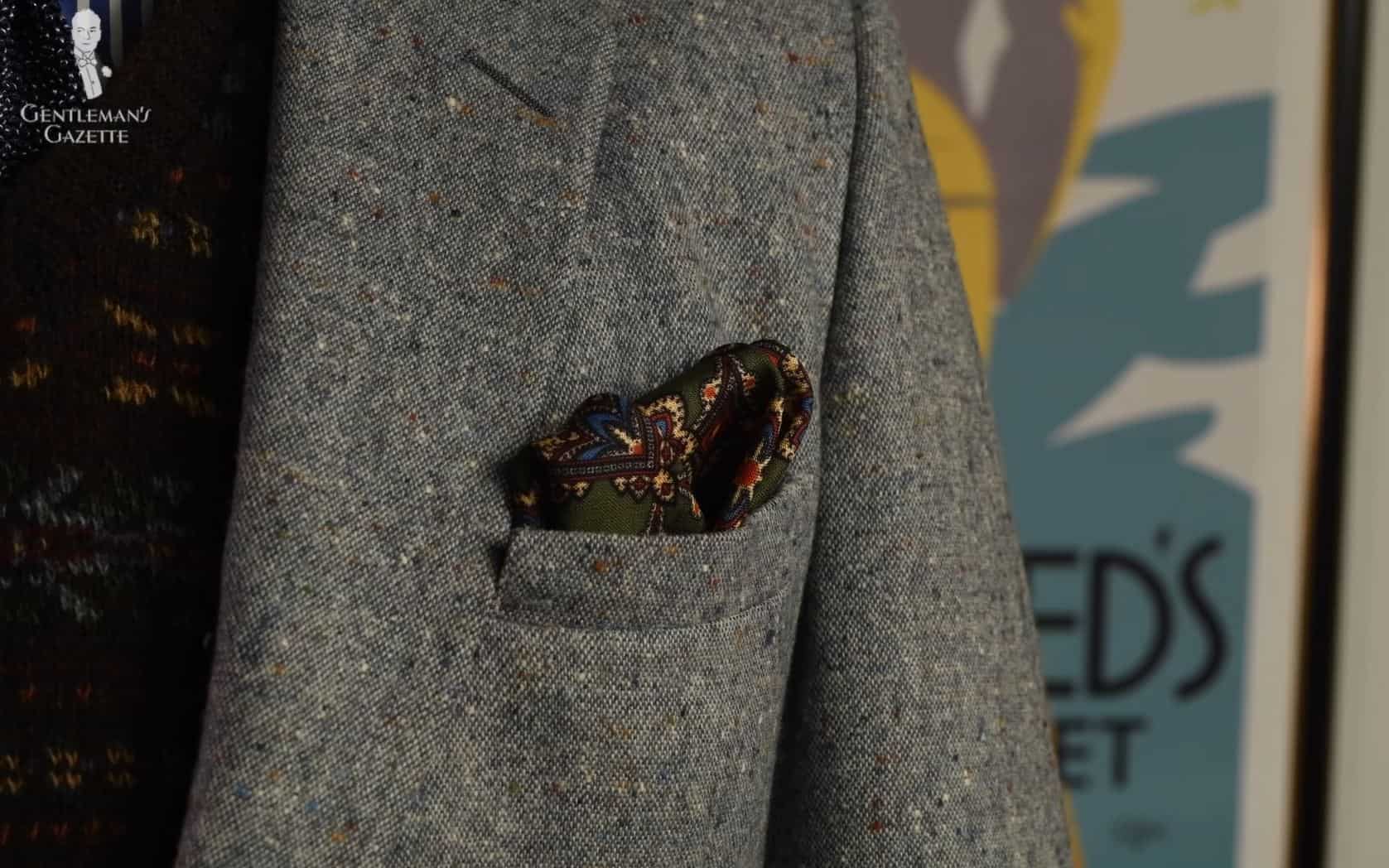
Casual or Formal
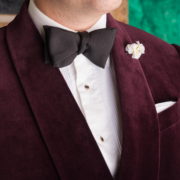
Formal
This guide will include information about the relative formality of each fold, and each Gentleman’s Gazette dress code guide, where applicable, includes further information about acceptable pocket square folds for each level of formality.
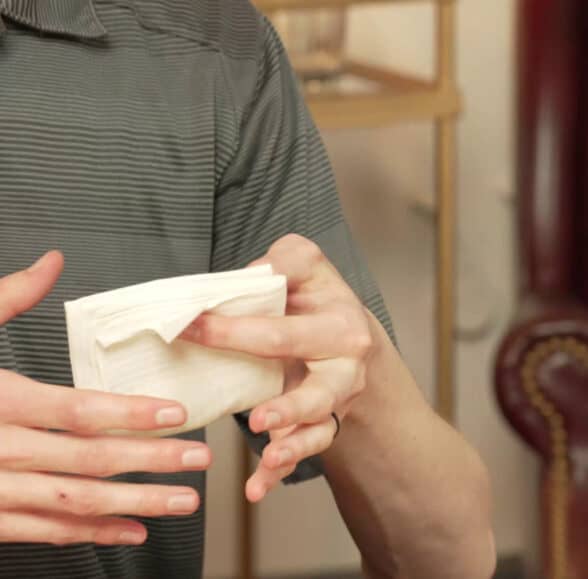
A pocket square and a handkerchief
Aren’t the Same
Although they can appear similar, a pocket square and a handkerchief are actually different menswear articles. The handkerchief is a utilitarian article intended to be used for practical purposes like mopping sweat from your brow or wiping away detritus. A pocket square is a decorative article intended to be worn in the breast pocket of your jacket. The difference can be pithily, if somewhat vulgarly, summed up in the expression “One is for blowing / The other for showing.”
The Classic Fold
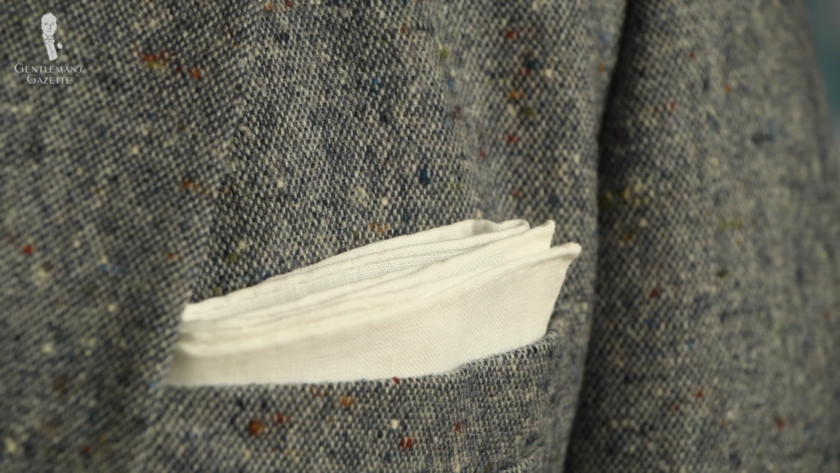
The Classic Fold is also known as the Square Fold, the Straight Fold, the TV Fold, or the Presidential Fold. It’s a very traditional fold, typically seen on news anchors, at formal weddings, and in more conventional professional settings like formal offices at a law firm. There is also a more casual variation on this fold discussed in further detail below. In general, this type of fold looks best with a cotton or linen pocket square that is relatively stiff, and the fold is traditionally associated with white pocket squares.
| Name: | The Classic Fold |
|---|---|
| Ideal Material: | Stiff Linen or Cotton |
| Ideal Pattern: | Solid Body or Bordered, especially with Contrast Edge |
| Formality | Casual to Formal (Depending on Variation) |
| Number of Points | None |
How To Fold The Classic Fold
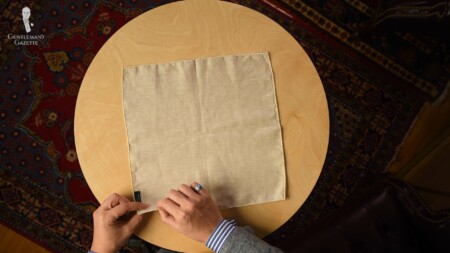
Open pocket square with hand-rolled edge facing up
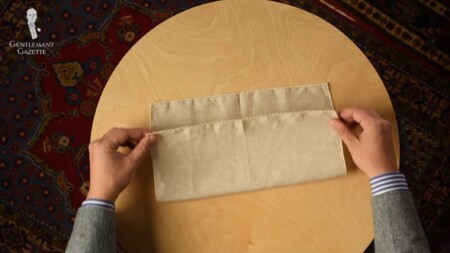
Fold the entire pocket square in half horizontally
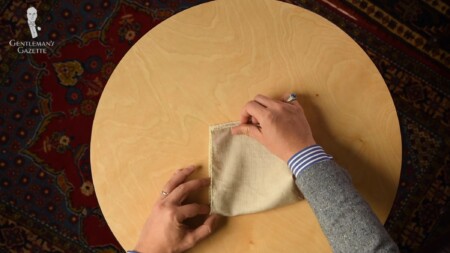
Rotate the pocket square 90 degrees and fold it in half horizontally
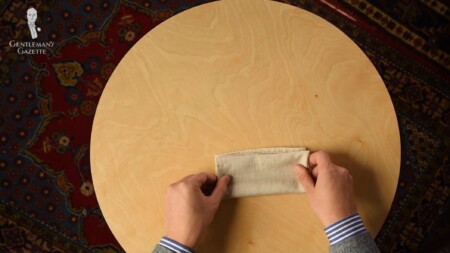
Fold the entire pocket square horizontally one last time
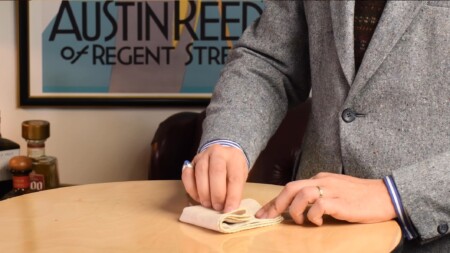
Depending on the depth of your pocket, fold up the lower quarter to third of pocket square and position it in your pocket
The Casual Variant on the Classic Fold
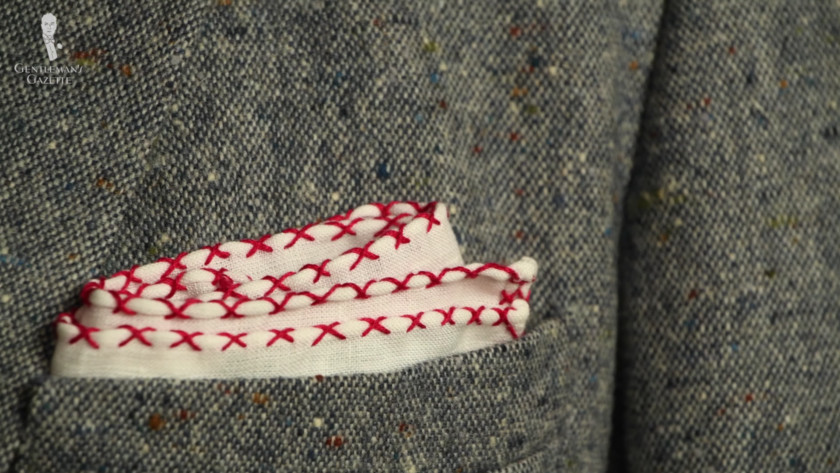
The Casual Variation on the Classic Fold has essentially the same steps as the original. However, when folding each half of the square, arrange the corners so that they are not completely straight when lining up the folded edges. This staggered appearance will allow more of the edge to show, highlighting any contrasting edges and giving the entire fold a more casual appearance.
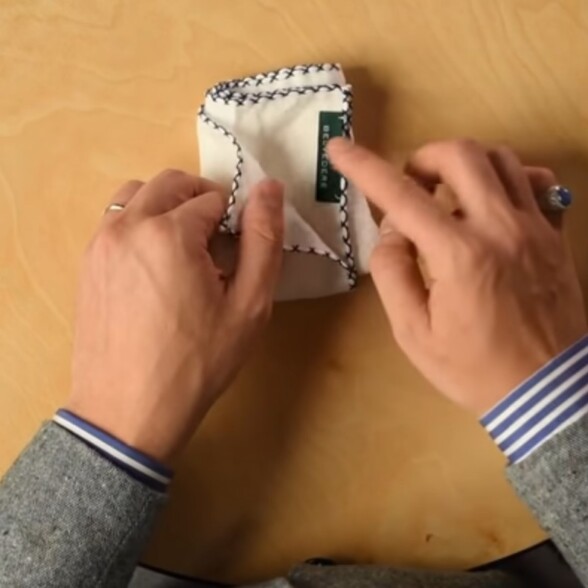
Visible Tags?
Tuck’em or Trim’em!
Any maker’s tags or cleaning instruction tags will appear distracting if they are visible in your fold. Therefore, either tuck the tag away so that it cannot be seen or remove the tag entirely. Be careful not to damage the body of the pocket square when removing the tag. Utilizing a pair of nail scissors or a seam ripper will minimize the chance of damaging any delicate fabric. Be sure to save any tags with cleaning instructions for later reference.
The Crown or Multi-Point Fold
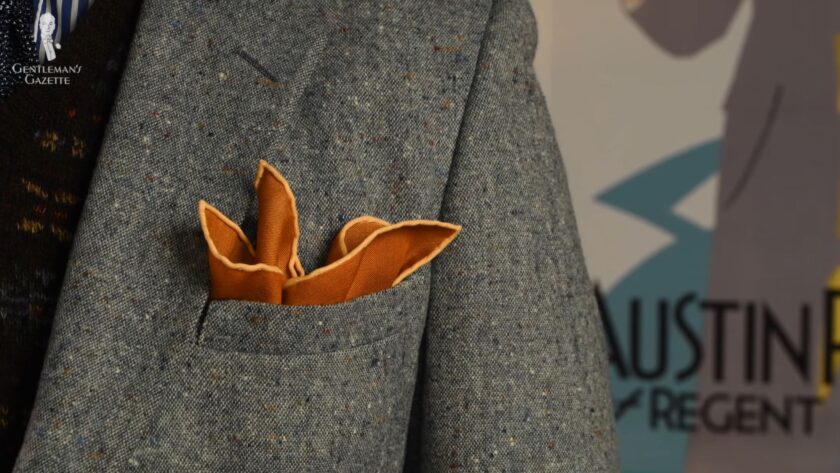
This regal yet refined pocket square fold emphasizes the edges of the pocket square, and as such looks particularly good with a contrast edge or some cross stitching. A slightly stiffer material will keep the points looking crisp and elegant, so this fold is ideally used with linen, wool, or wool-silk pocket squares. Silk can also be used, but be sure that the pocket square is large enough to stay seated in the pocket and that the material is stiff enough to avoid lank points.
| Name: | The Crown or Multi-Point Fold |
|---|---|
| Ideal Material: | Stiff Linen, Wool, Silk, or Wool-Silk |
| Ideal Pattern: | Bordered, especially Finished or Contrast Edges |
| Formality: | Casual to Semi-Formal |
| Number of Points: | One Point, Two Point, Three Point, or Four Point |
How To Fold The Crown Fold
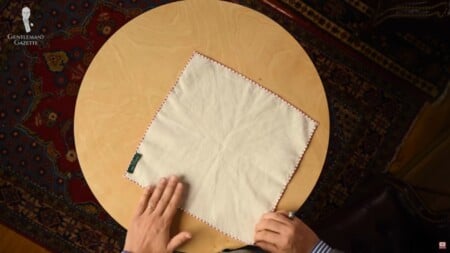
Lay the pocket square flat on its reverse side in a diamond shape
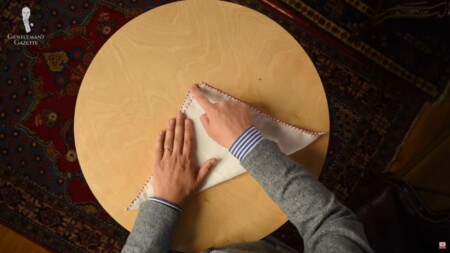
Horizontally fold the pocket square into a triangular shape, ensuring that the top points are slightly off and not overlapping.
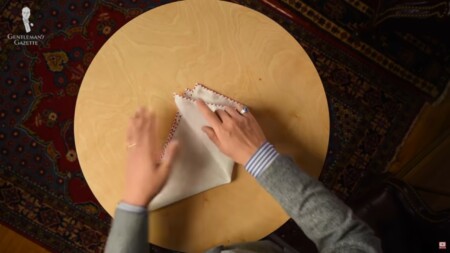
Fold the right-most corner over to the left-most side
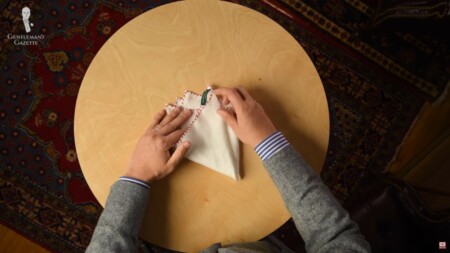
Fold the left-most corner over to the right-most side
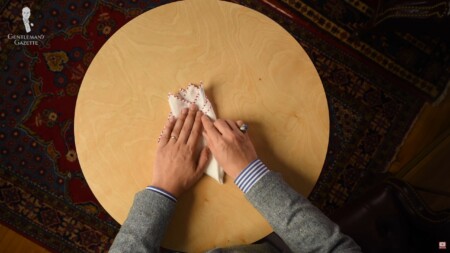
Fold the excess fabric on the right side of the fold into the middle
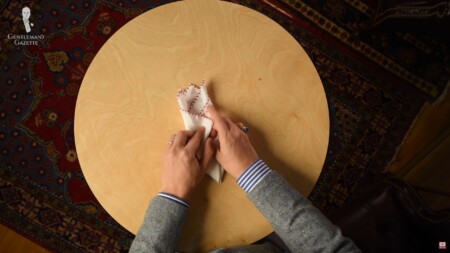
Fold the excess fabric on the left side of the fold into the middle
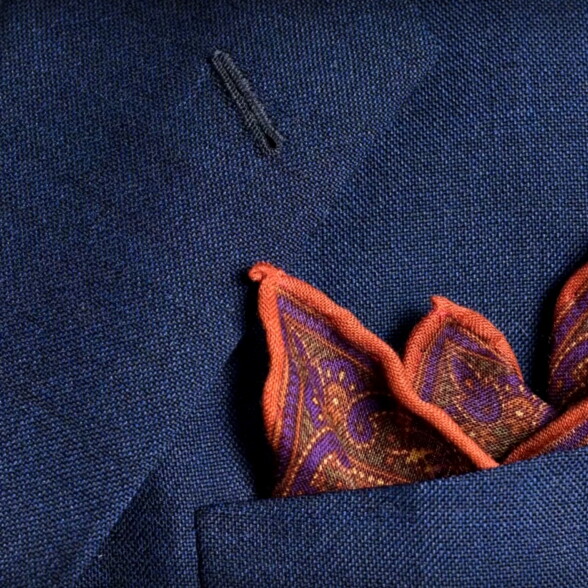
The Importance of
Hand-Rolled Edges
For the crown fold or any fold that emphasizes the edges of the pocket square, you want to make sure that you have hand-rolled edges. They look much nicer than machine-hemmed edges and have improved functionality. A pocket square is a decorative piece, and because of that, you always want to have the best possible edge, and nothing surpasses hand-rolled edges.
Learn About Hand-Rolled Edges and Other Important Aspects of Pocket Square Construction with This Video!
The Puff or Pinch Fold
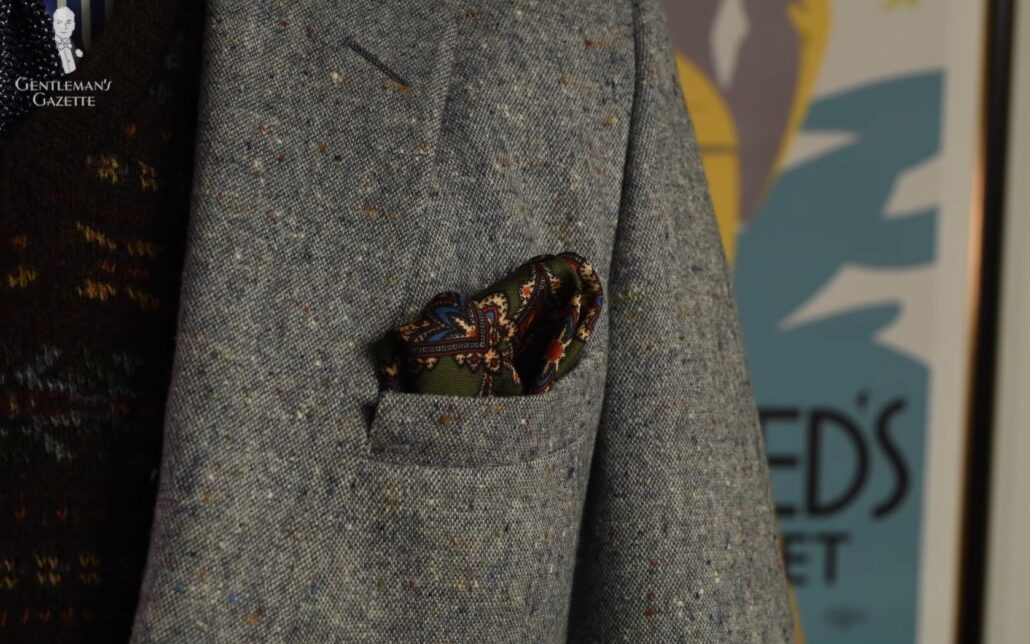
This fold is a perennial favorite of the Classic Style and has a very unique, understated appearance with a vintage feel often associated with tuxedo styling of the 1920s. It appears especially dapper in a silk or silk-wool blend, because the folds break in a very sophisticated way. Be wary of using a stiff material, like linen, as it will likely work its way out of your pocket over the course of the day and look unappealing.
| Name: | The Puff or Pinch Fold |
|---|---|
| Ideal Material: | Silk or Silk-Wool Blend |
| Ideal Pattern: | Solid, Repeating Pattern, or Graphic Body |
| Formality: | Casual to Formal |
| Number of Points: | None |
How To Fold The Puff Fold
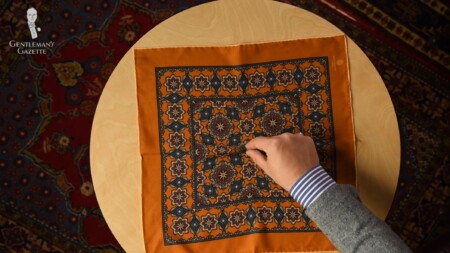
Lay the pocket square on its obverse side and pinch the middle
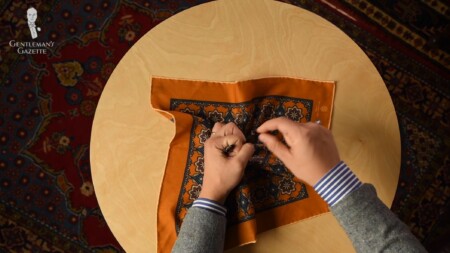
Draw the middle of the pocket square through a hole made with the fingers of your other hand
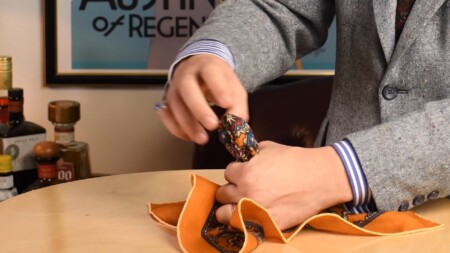
Draw out the desired length of the pocket square
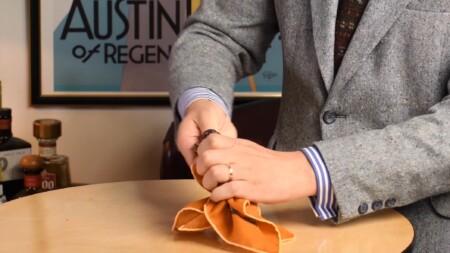
Twist the pocket square in the middle to secure the fold
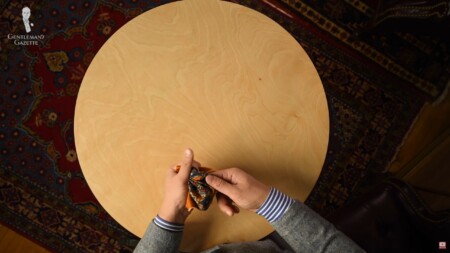
Adjust the fold and then place in your pocket
The Secret to the Perfect Puff
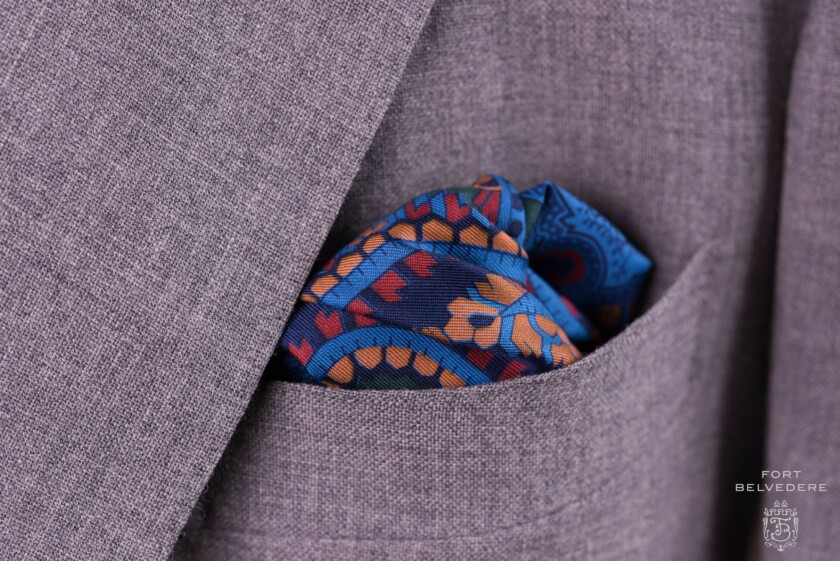
Some wearers will press the top of the puff down into itself to create a more organic, irregular puff shape. Eventually, however, this indentation will expand and you will be left with a big, poofed-out puff that is not very elegant. Instead, to achieve a more durable irregular shape, take the square by one corner and tuck it into your pocket, then repeat with the other three corners until you’re left with a puff that you like.
Note that using this method does not allow you to secure the pocket square with a final twist.
The Upside-Down Puff or Upside-Down Pinch Fold
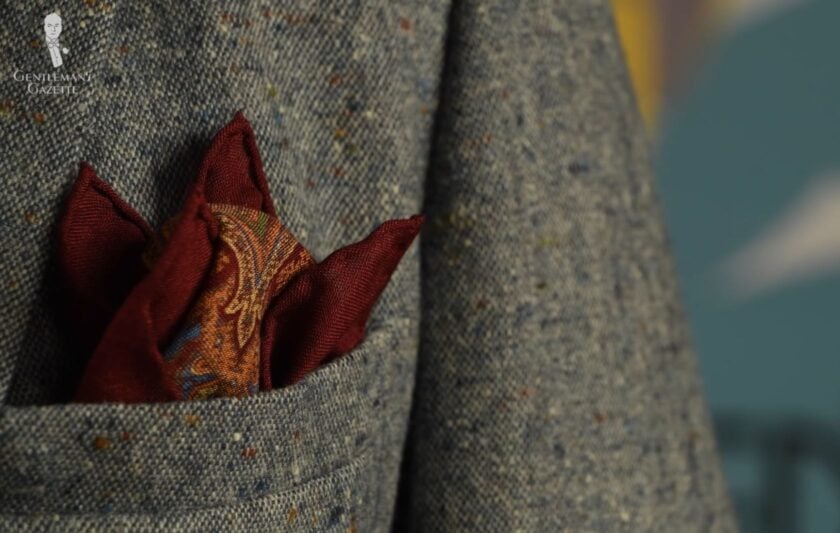
This elegant fold combines the plush texture of the Puff Fold with the structure and dramatic flair of the Crown Fold. It works especially well with a silk or silk-wool pocket square, and stiff materials should be avoided to ensure good drape and a secure seat.
You can control the exact look of the pocket square by arranging how many and where the points are positioned, from a one-point fold to a four-point fold, so this fold can be altered to individually suit the particulars of the pocket square from which it is made.
A Curated Collection of Medallion Pocket Squares to Suit Any Ensemble
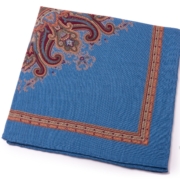
Blue Mohair Pocket Square with Burgundy Medallion
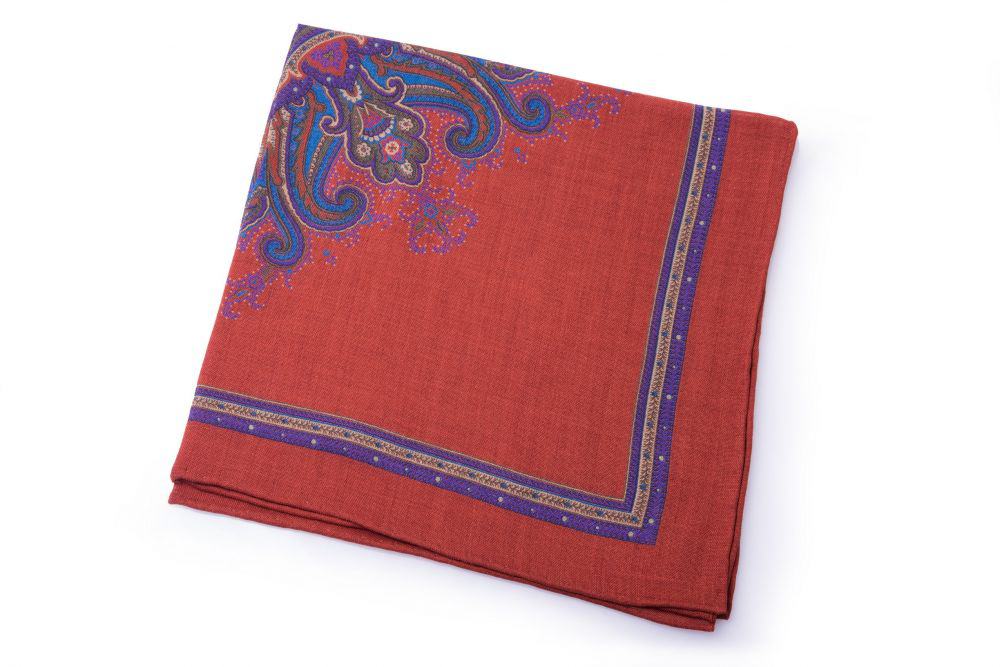
Orange Silk-Wool Pocket Square with Blue Medallion
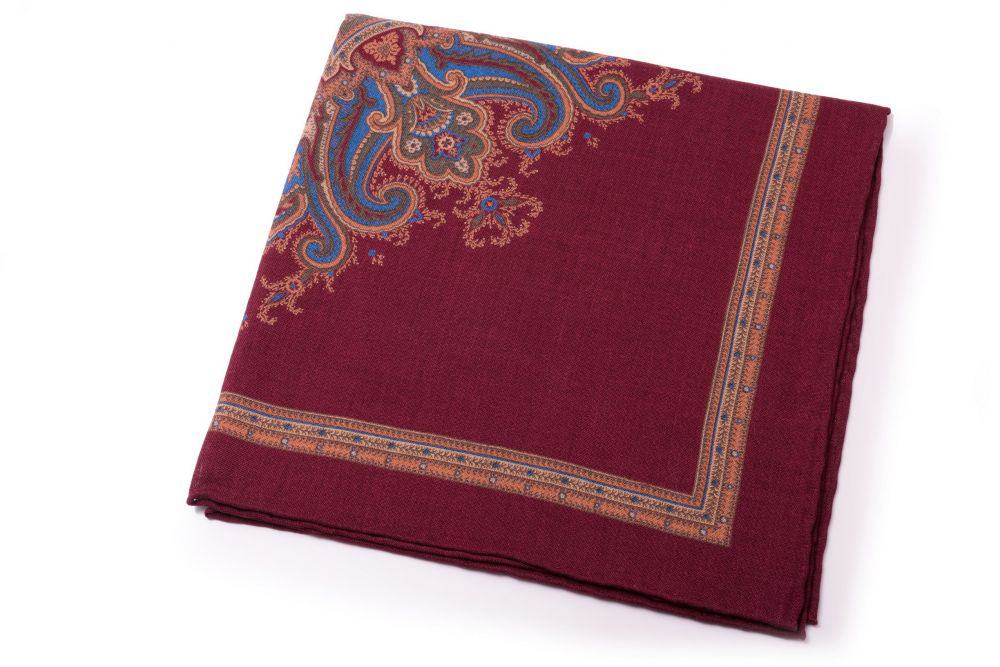
Red Silk-Wool Pocket Square with Blue Medallion
To maximize the visual interest of this fold, the body of the pocket square should be noticeably distinct from the detailing on the edge. This will ensure maximum versatility and flexibility as you craft a memorable look. A central medallion design will be especially fetching as this fold displays the body of the pocket square in a prominent but unexpected way.
| Name: | The Upside-Down Puff Fold |
|---|---|
| Ideal Material: | Silk or Silk-Woold Blend |
| Ideal Pattern: | Strong Distinction between Body and Border, and Medallion-Design Body |
| Formality: | Business Casual to Semi-Formal |
| Number of Points: | One Point, Two Point, Three Point, or Four Point |
How To Fold The Upside-Down Puff Fold

Follow the same basic steps as the Puff Fold. Lay the pocket square on its obverse side and pinch the middle

Draw the middle of the pocket square through a hole made with the fingers of your other hand

Draw out the desired length of the pocket square

Twist the pocket square in the middle to secure the fold
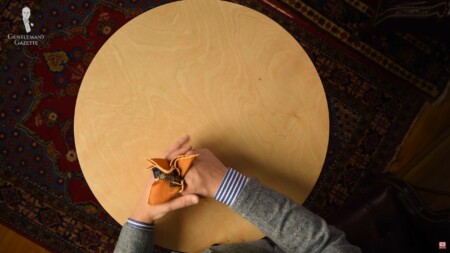
Fold the pocket square in half so that the end with the points rests behind the puff. Adjust points as desired and place in pocket.
The Shell Fold
This fold is very unusual and is not seen very often because it requires practice and a bit of work to look perfect. When done properly, however, it is a very special fold that can add an unexpected twist to formal attire in particular.
The Shell Fold requires a relatively large pocket square made from silk or silk-wool, to ensure that the elements are seated properly in the pocket and do not slip down. Silk-Wool pocket squares will have a very subtle matte appearance, while a silk pocket square will appear more vibrant.
| Name: | The Shell Fold |
|---|---|
| Ideal Material: | Silk or Silk-Wool Blend |
| Ideal Pattern: | Solid, Repeating Pattern, or Graphic Body, and Bordered with Contrast Edges |
| Formality: | Business Casual to Formal |
| Number of Points: | None |
How To Fold The Shell Fold
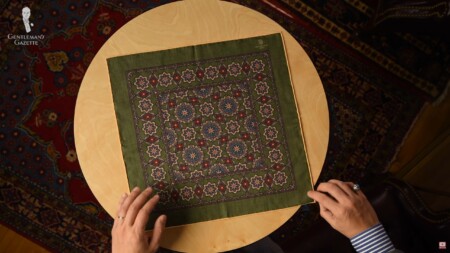
Lay the pocket square flat on its reverse side
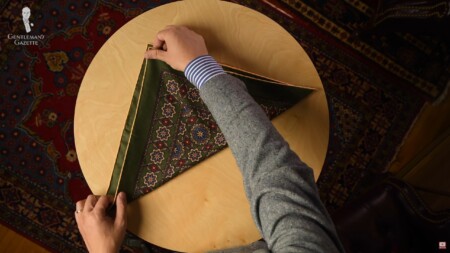
Fold the pocket square diagonally to create a large triangle
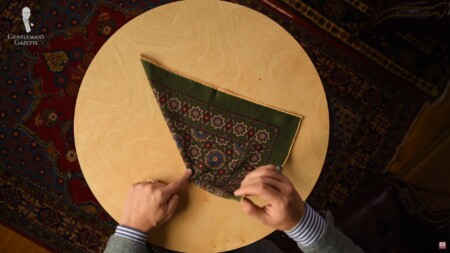
Place your forefinger in the center of the long edge and fold in half again, making another triangle. This time, however, leave the corners slightly separated so that the folded edge is at a slight angle and not a straight line
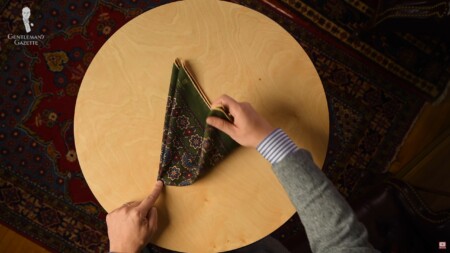
Take the corners opposite of the angled edge and fold them up to the top corners, again creating a slight angle. The result should resemble three slightly askew stacked triangles
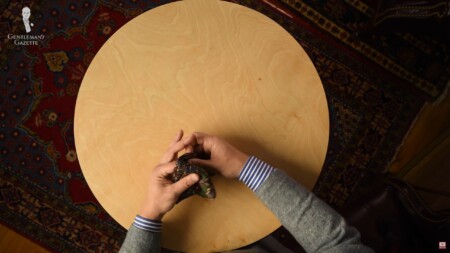
Fold in the center of the stacked edges, leaving you with three "shells" on one edge of the pocket square

The Scallop Fold
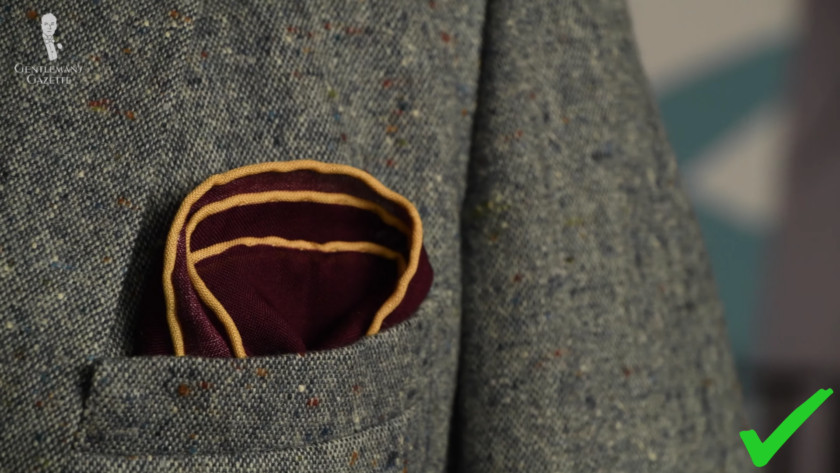
This fold is another example that really highlights the beauty of the pocket square’s edges and so is well-suited to contrast edges or any visually interesting edge designs. In fact, the border is a key component of the style of this fold. It also has a pleasing organic curve that is very polished.
| Name: | The Scallop Fold |
|---|---|
| Ideal Material: | Cotton, Linen, Wool, Silk, or Any Blend |
| Ideal Pattern | Bordered with Strong Contrast Edges, such as prominent rolls or x-stitching. |
| Formality: | Business Casual to Formal |
| Number of Points: | None |
How To Fold The Scallop Fold
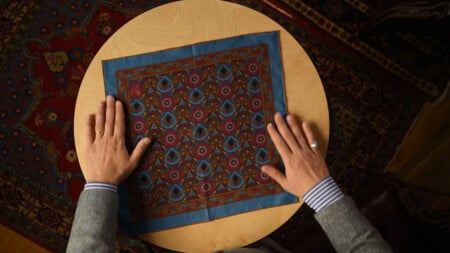
Lay the pocket square flat on its reverse side
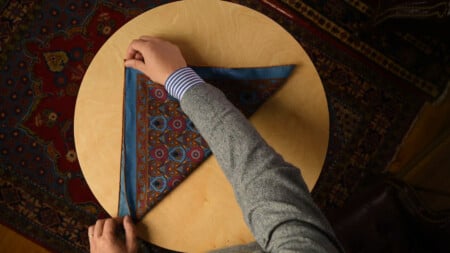
Fold in half diagonally, leaving the edges exposed and slightly askew
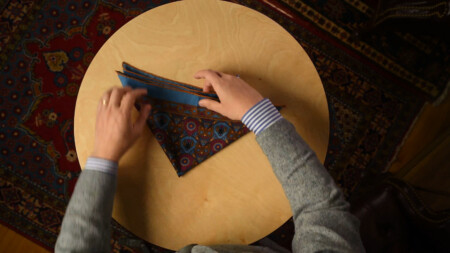
Fold in half again along the long, folded edge, again at a slight angle, so you’re left with a triangle whose long side shows multiple pocket square edges
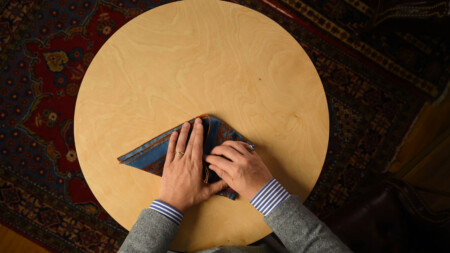
Orienting the exposed edge-side upwards, fold the right edge in to the center point
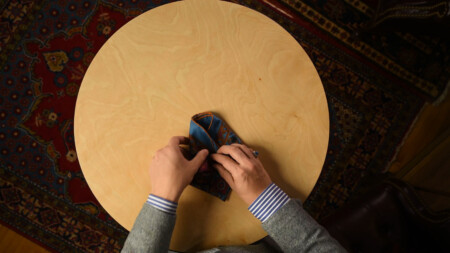
Fold the left edge in to the center point
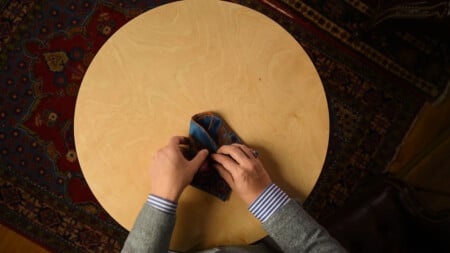
Fold the new right edge to the center point
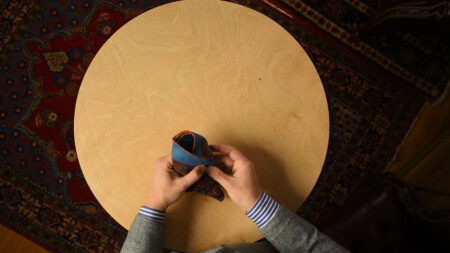
Fold the new left edge to the center point
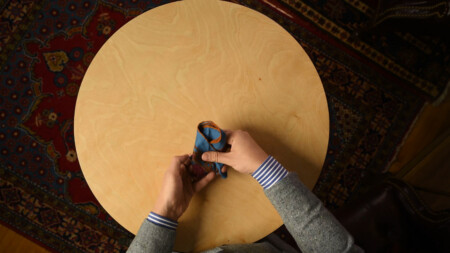
Fold horizontally to fit fold to the depth of your pocket
Adjusting the Scallop Fold for a More Organic Look
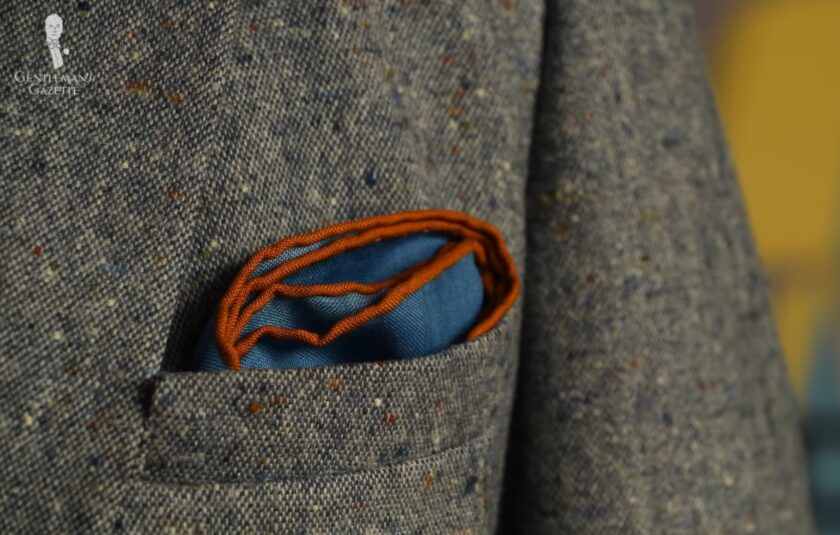
Once the square is in your pocket, adjust the scalloped edges so that they are a little more elegant and nonchalant. If you’d like, you can also perform the last fold slightly asymmetrically to get a more unusual, elliptical curve. This will ensure that the fold has a natural look that is not too studied.
The Rose Fold
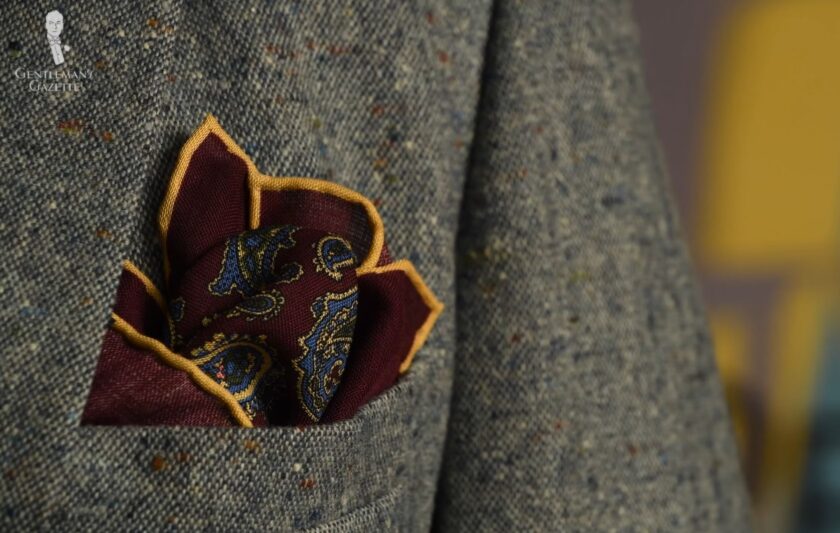
As elegant as a formal boutonniere, this fold combines pleasing organic shapes with strong, natural lines. To emphasize the harmonious elements of the fold, consider utilizing a pocket square that features a center medallion and contrast edges to maximize visual interest.
| Name: | The Rose Fold |
|---|---|
| Ideal Material: | Cotton, Linen, Wool, Silk, or Any Blend |
| Ideal Pattern: | Medallion or Repeating Pattern Body, and Bordered with Contrast Edges, with Reverse Decoration |
| Formality: | Business Casual to Semi-Formal |
| Number of Points | None |
How To Fold The Rose Fold
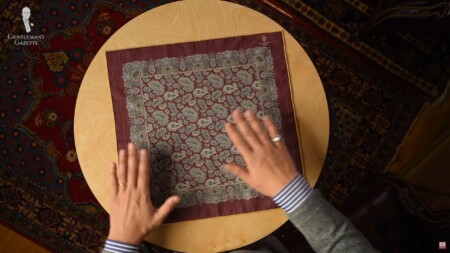
Open the pocket square fully on its reverse side
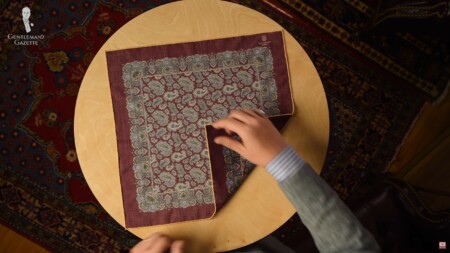
Fold the bottom right corner to the center point
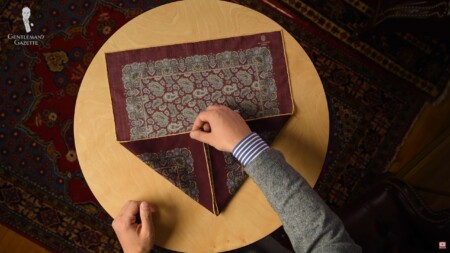
Fold the bottom left corner to the center point
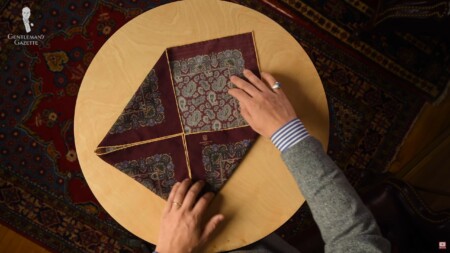
Fold the top left corner to the center point
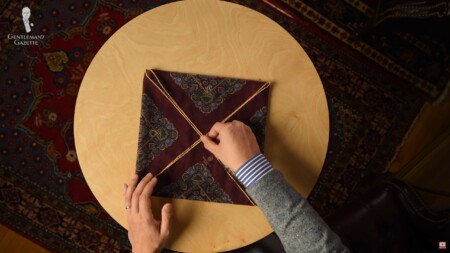
Fold the final corner to the center point. The result should be a diamond shape similar to a folded envelope or package
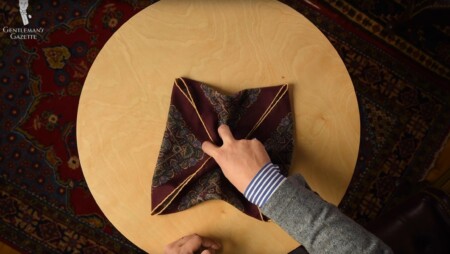
Using your dominant hand formed like a claw, grab the center of the fold, being sure to grip each of the sections.
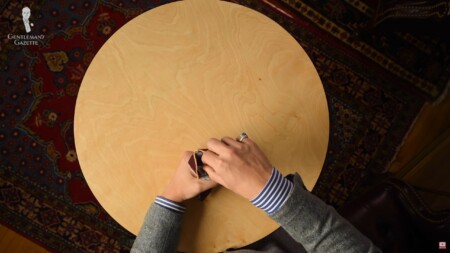
Grip the center of the mass with your non-dominant hand. Adjust the fold so that the central portion drapes nicely before placing in your pocket
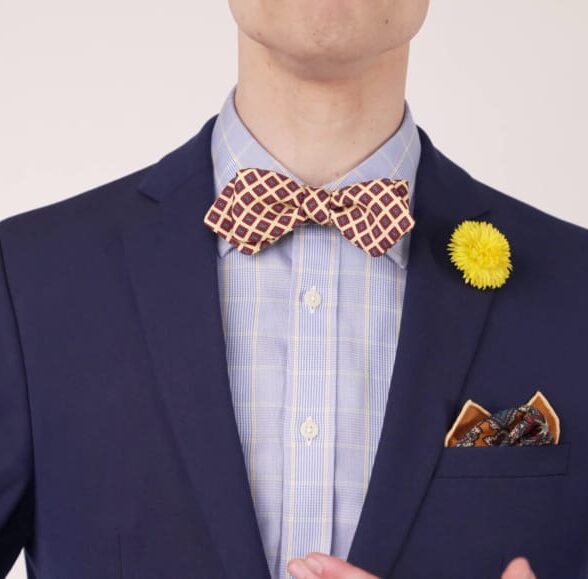
A boutonniere and a Pocket square? Most of the Time, It’s Just Fine!
The Rose Fold will likely put you in mind of flowers, like the flowers that appear in the lapel as a boutonniere. For the vast majority of cases, it is perfectly acceptable to wear both a boutonierre and a pocket square if you desire to do so. The only exception will be if you happen to be wearing a very large, very ornate boutonniere. In such a case, the dramatic boutonniere is likely to overshadow your pocket square, and the combination of the two together will simply look too busy.
Learn more about boutonnieres right here!
The Angel’s Peak Fold
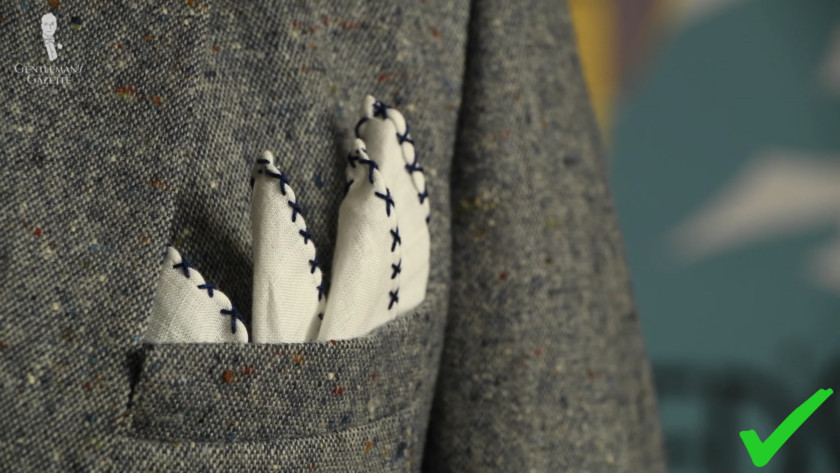
This fold enjoys considerable popularity in Contemporary Styling and is similar to the Crown Fold, but emphasizes height and a sense of structure. It works especially well with more modern looks and, when executed properly, can be very dashing.
| Name: | The Angel’s Peak Fold |
|---|---|
| Ideal Material: | Linen, Cotton, Wool, or Blends of Same |
| Ideal Pattern | Solid and Bordered with Contrast Edges, especially X-Stitching |
| Formality: | Casual to Business Attire |
| Number of Points | Three Points or Four Points |
How To Fold The Angel’s Peak Fold
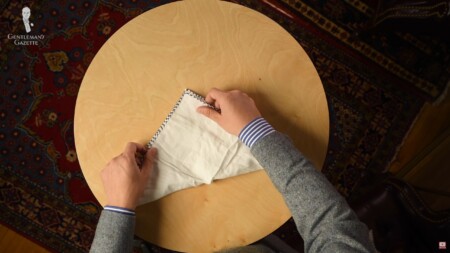
Fold the flat pocket square diagonally to make a triangle
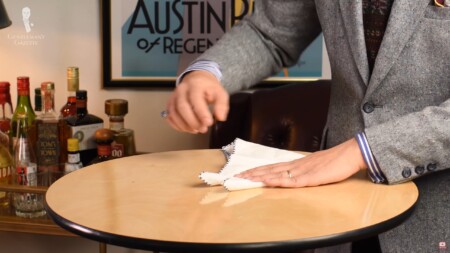
Fold the right corner of the triangle so that it is slightly to the left of the central point
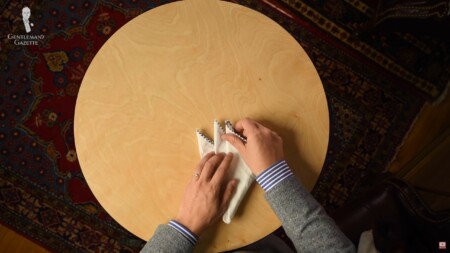
Fold the left corner of the triangle so that it is slightly to the left of the central point
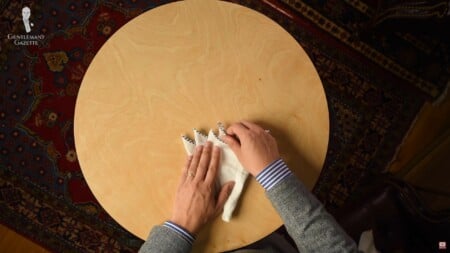
If desired, you can unfold the third point to reveal a fourth point
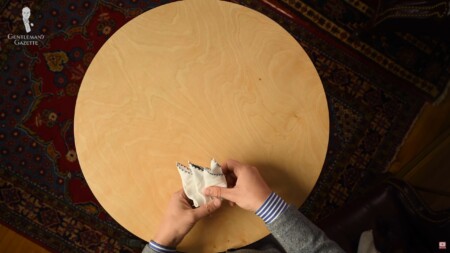
Fold in half horizontally to match the depth of your pocket. To avoid appearing too precise or stuffy, adjust the relative height of the points by pulling them up or down. This more effortless look will seem more natural and visually pleasing.
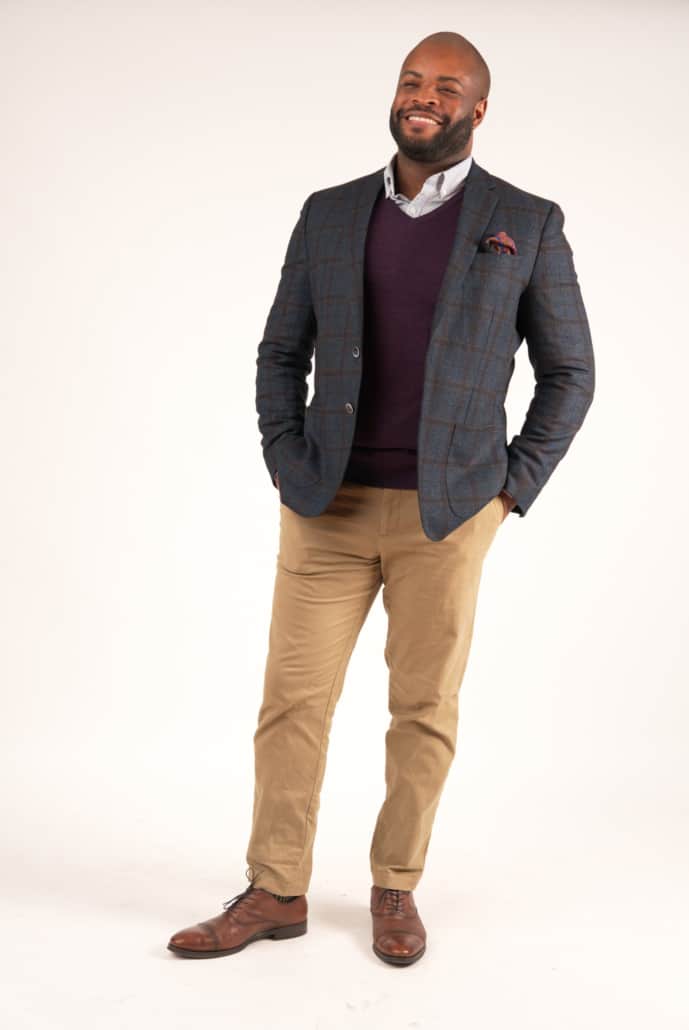
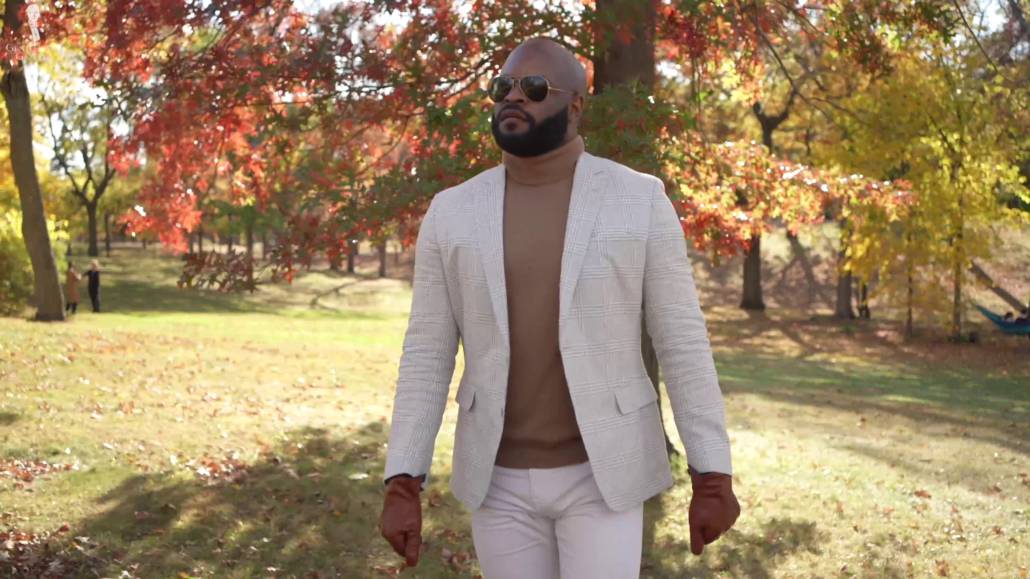
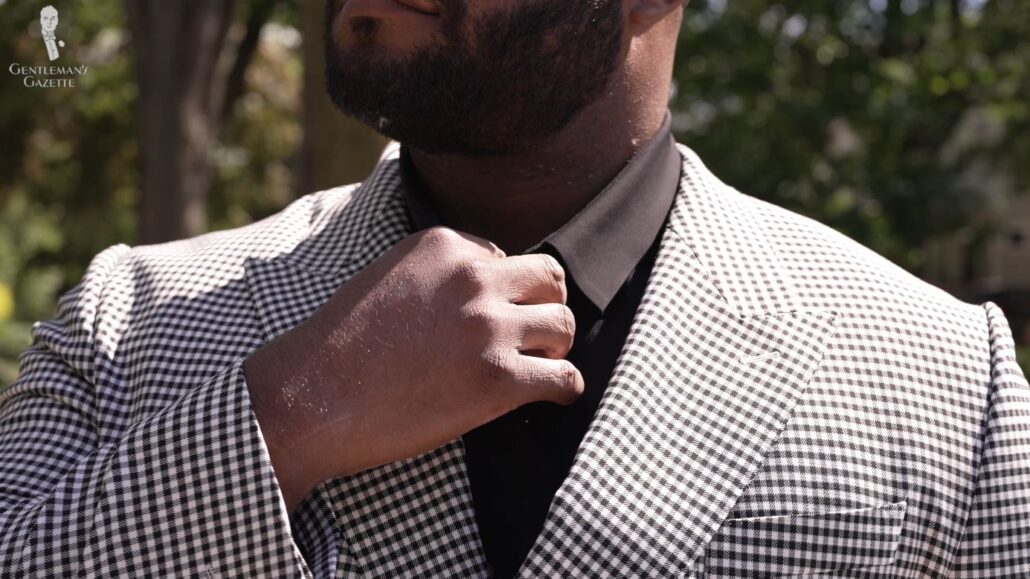
Bonus: The Stair Fold
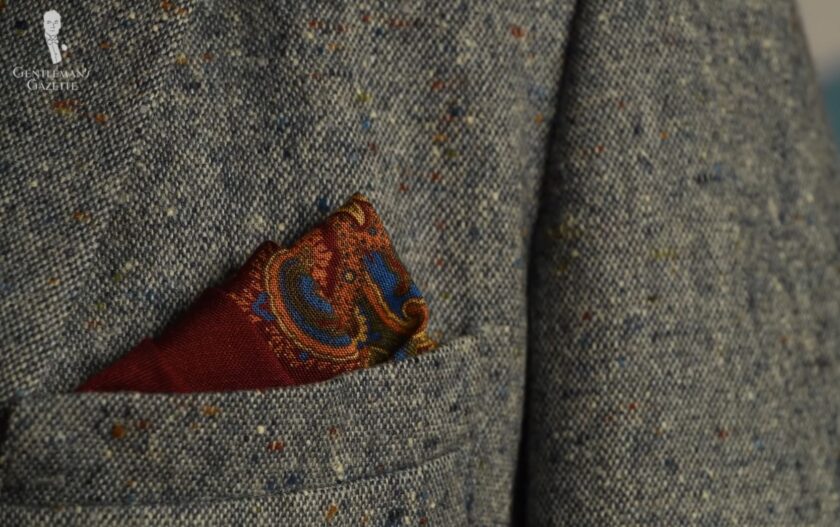
Another popular Contemporary Fold, the Stair Fold can be troublesome because when executed poorly, it resembles a prepackaged, ersatz pocket square. When employed with the right pocket square, however, it can look spectacular.
In our experience, the Stair Fold requires a silk-wool blend that is soft enough to drape in a pleasing way that helps improve the definition of the pattern. Anything overly creased or springy, like linen, will look flat and fake. The pocket square should also have a center medallion and a contrast edge for pop that shines through the rigid structure of the fold.
| Name: | The Stair Fold |
|---|---|
| Ideal Material: | Silk-Wool Blend |
| Ideal Pattern: | Center Medallion Body and Bordered with Contrast Edges |
| Formality | Business Casual to Semi-Formal |
| Number of Points | One Point |
How To Fold The Stair Fold
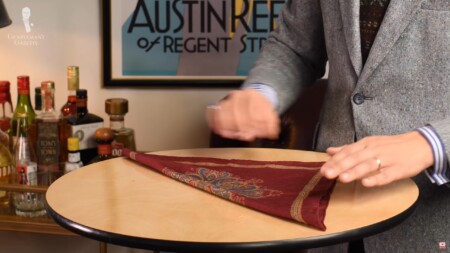
Fold the flattened pocket square on its reverse side diagonally into a triangle, with the main point pointed towards you
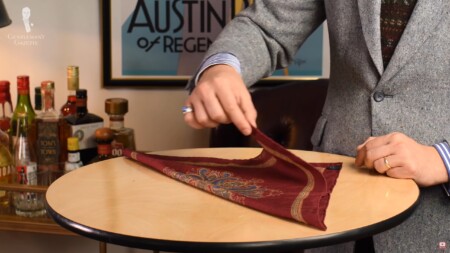
Taking the tip of the top layer of the point facing you, gentle pull it away from you
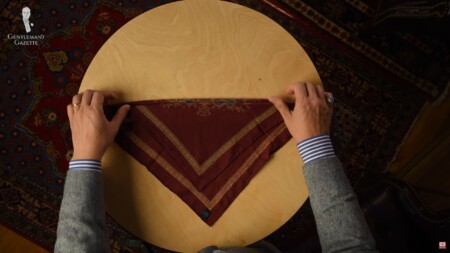
Create a fold in the pocket square along its horizontal edge and then bring the tip back towards you, but not all of the way back to the edge of the main tip
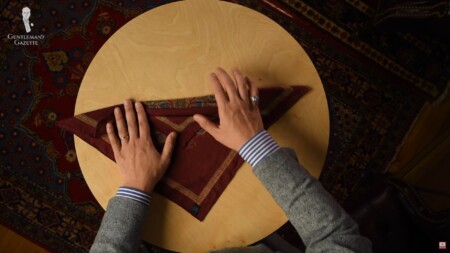
Repeat this procedure until you have created three or four stacked folds along the outer edge, layering the tips along the middle line of the fold
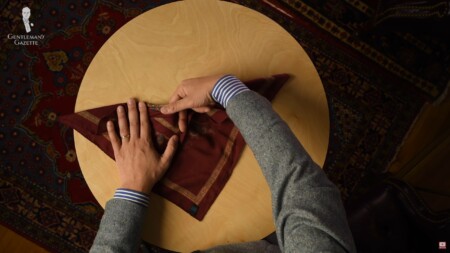
Place the middle finger of your dominant hand under the folds in the middle of the pocket square
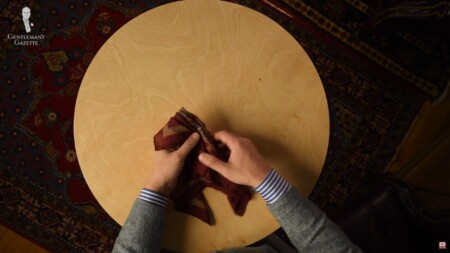
With your non-dominant hand, gather the pocket square together in the middle
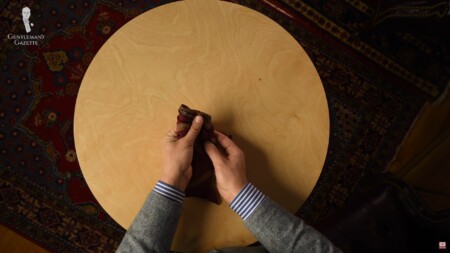
Fold the excess fabric on the right side under the pocket square
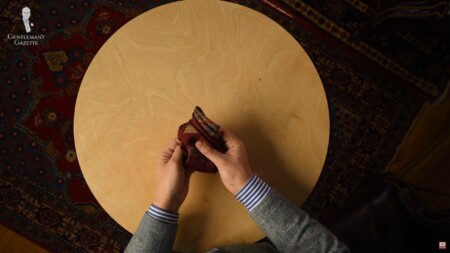
Fold the excess fabric on the left side under the pocket square
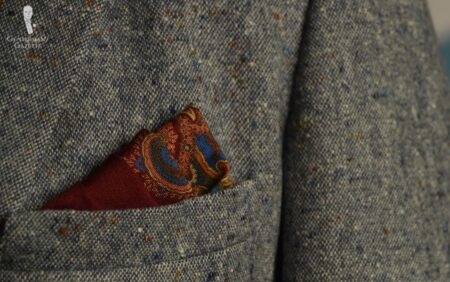
The point can either point toward or away from your tie, whichever you prefer. As with the shell fold, pull a little bit on each fold and try for a nonchalant look.

To “Brummell” or Not to “Brummell?”
Early menswear influencer Beau Brummell was said to spend hours every day making it appear as though every article he wore had been casually thrown on, when in reality, he had artfully arranged each element “just so.” This styling concept, usually identified today with the Italian concept of sprezzatura, is commonly applied to pocket square folds. Throughout this guide, you will notice references to tips and tricks to make a pocket square fold appear more natural and less studied. More organic styling will generally make a pocket square look more elegant, and will ensure that no one mistakes it for a pre-packaged, fake pocket square. That being said, if you prefer a more mathematical appearance, the choice is yours: you should feel free to arrange your pocket square folds in whatever way best suits your style.
Conclusion
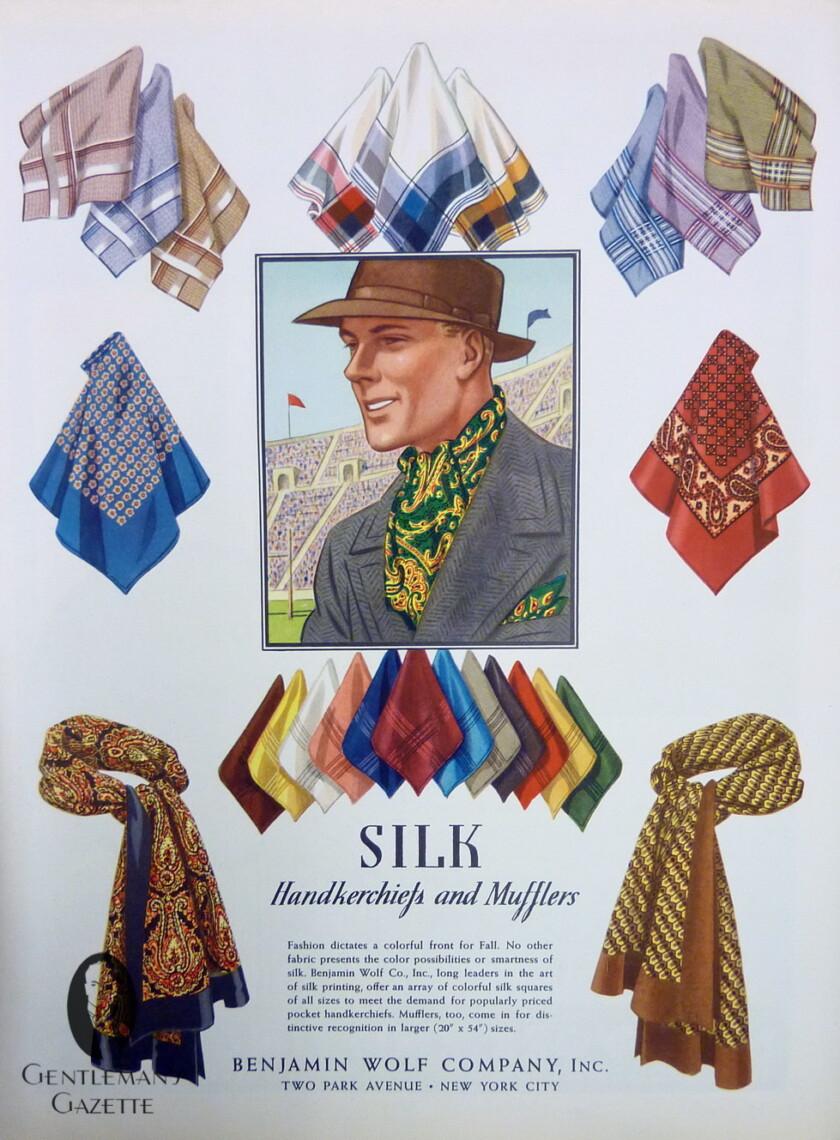
Now that you have learned the basics of how to fold eight classic pocket square folds, you should know that your folding adventure is only beginning. In addition to practicing folds, you should also experiment to discover new variations that suit your own style. Every pocket square fold will naturally be slightly different, so embrace this opportunity to be as creative as you want!
And let us know what your favorite folds are in the comment below!
Just remember, a quality pocket square is essential for a quality pocket square fold, so make sure that you invest in elegant, well-made pocket squares with timeless style.
Find the best pocket squares at Fort Belvedere!
Outfit Rundown
In the video accompanying today’s article, Raphael is wearing a vintage Donegal tweed coat in grey with color flecks that he has combined with a Fair Isle sweater vest from Ralph Lauren. It has a v-neck, so it works well with the blue and light blue mottled silk knit tie which you can find in our shop. His shirt is blue and white striped, which picks up the color of the tie as well as his chino pants in navy, but it also harmonizes and picks up the color of the Fort Belvedere pocket square in white linen with contrast cross edge stitching.
For socks, he chose a pair of shadow striped over-the-calf socks in gray and red from Fort Belvedere. They pick up the red color of the shoes and tie together with the jacket and the pants.
His cufflinks are silver platinum plated monkey fist knot links from Fort Belvedere, and he is combining them with a pinky ring which is kind of a scratched white gold with a very interesting texture, and an artificial blue sapphire which picks up the blue tones of the outfit and ties it all together.
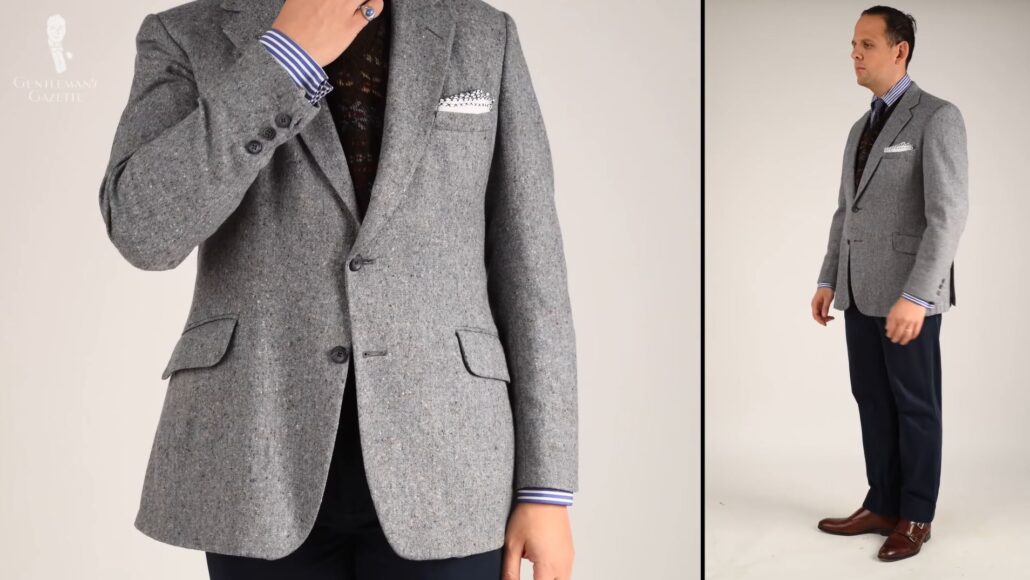
Previous Pocket Square Fold Content
Today’s article and video are updated versions of an earlier pocket square fold video made in 2014. If you’d like to see how far the Gentleman’s Gazette has come in the intervening years, you can find the original video below.



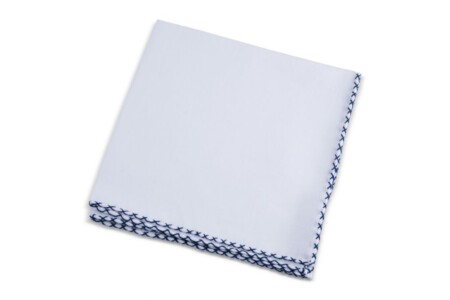
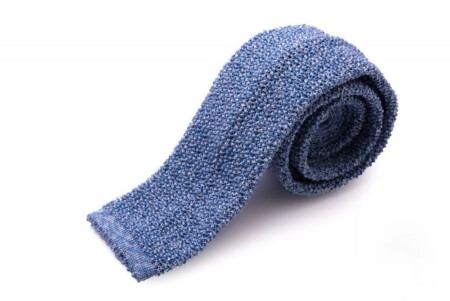
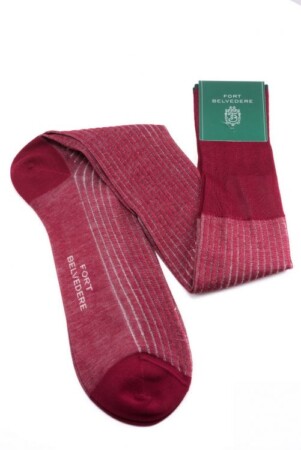
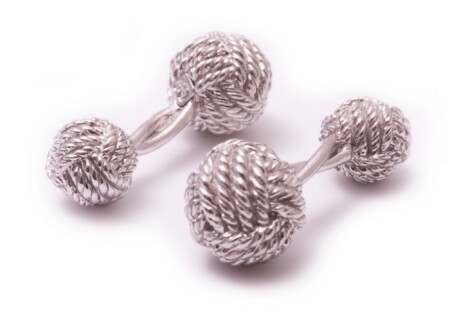

Great video, very useful.
Also, I hate being the guy that asks about the music instead of the actual video, but what is the piano piece that appears?
Great lesson.Handsome 3pc with DB vest in the video.Is it from A Caraceni?.
Nik
Indeed!
Great video as you discussed the 5 basic folds you also spoke about varies sizes small medium and large and I’m just wondering if there are standard sizes associated with those? Also I’ve recently seen what are called half round or half moon shape pocket squares what is your thoughts on that?
Park
Great video lesson, I’d like to address that some silk pocket sqaures tend to want to puff out of the pocket sometimes.
I have a few from Polo/Ralph Lauren that are very nice in desgin, but the silk is very slippery and wants to do it’s own thing at times.
I find that stiffer silks such as those from Robert Talbott give a nice hold. :)
Linen, cotton, and wool are by far some of my favorites. :)
Slippery silk is usually not good, but that’s why you do the half turn, it helps. But ideally, you get some heftier silk, like the ones from Fort Belvedere. The one’s I have seen from Robert Talbott were ok, but I am not sure all of their squares come from the same source…
You’re right about the RT pocket squares.
I’ve labels from them read England, Italy, and China.
My favorites are from England.
Meant to say I’ve seen labels. :)
One of the most understated aspects of fine male fashion – thanks for this tutorial!
You are welcome Chris!
Great post!
Glad you liked it!
I can’t tell you how much I appreciate this video! My brother just got married and I was his best man. Well, all the groomsmen and i had tried our rentals on and everything, but come the day of the wedding, I realized that my brother’s pocket square had been shell folded by a guy at the tux shop. Thank you so much for this video as it is the only way i was able to match everyone else’s pocket squares to his!! Truly a lifesaver. I love this site!!
Thank you Zach!
You’re welcome Zach!
Greetings,
So nice to have the various folds explained.
Now, I can see the Harry S. Truman and JFK styles those Presidents always sported in their fashionable expressions.
Many thanks for the tutorial!
Sincerely,
Andrew Gregg,
Palm Springs, CA.
It is our pleasure. :)
Thank you very much. After what I suppose was an ancillary effect of a major incident some years ago I have tried to utilize the wardrobe I already have to greater effect and when in doubt dress up more than down. That said I must admit to not always being, uh, spot on perhaps, with the pocket square. I think them a wonderful accent and opportunity to add a dash of sprezzatura to life. This post is very helpful.
This website needs an app! Real Men Real Style has one; I need my Gentleman’s Gazette on the go! Haha.
Hey Frank, I’d just like to say that I notice the effort you put in to create such a positive and vibrant community, and I want to tell you to have a nice day :)